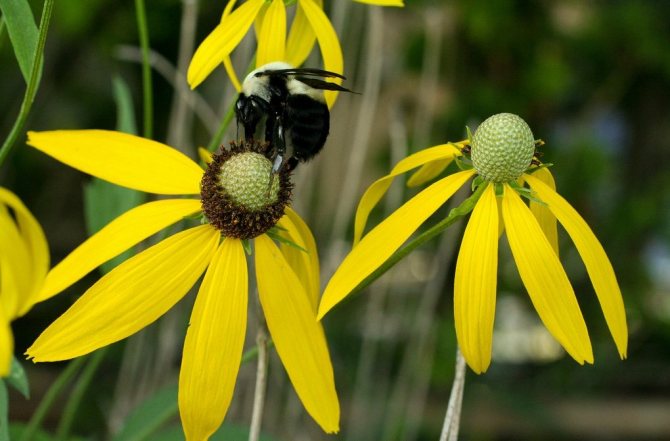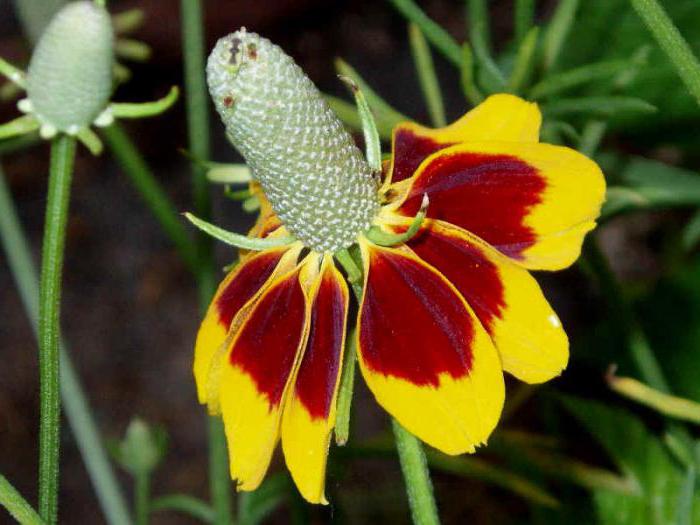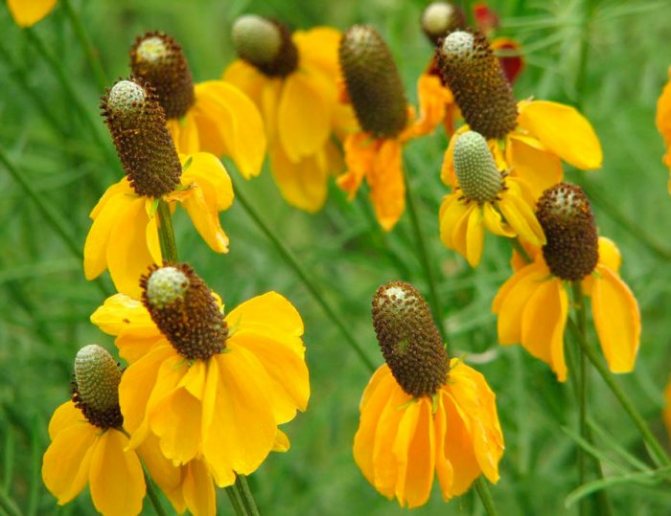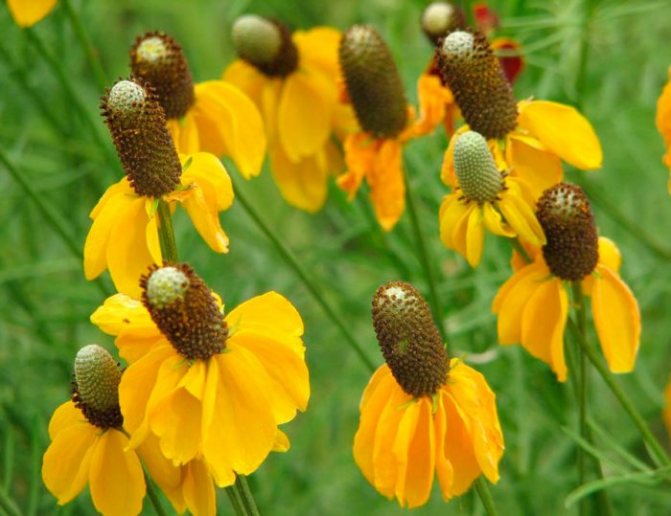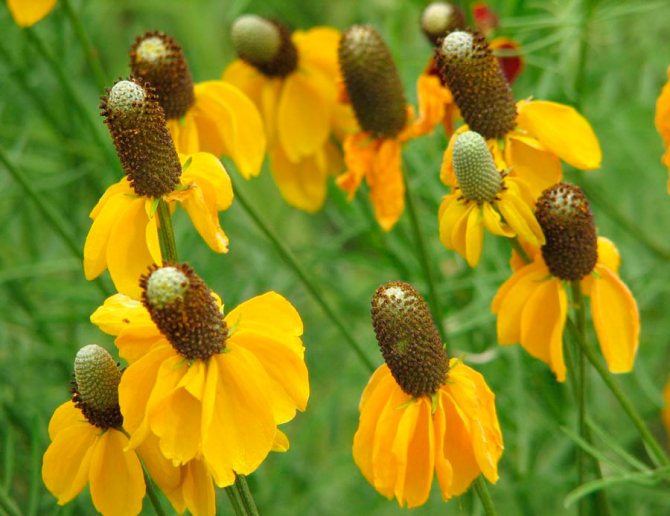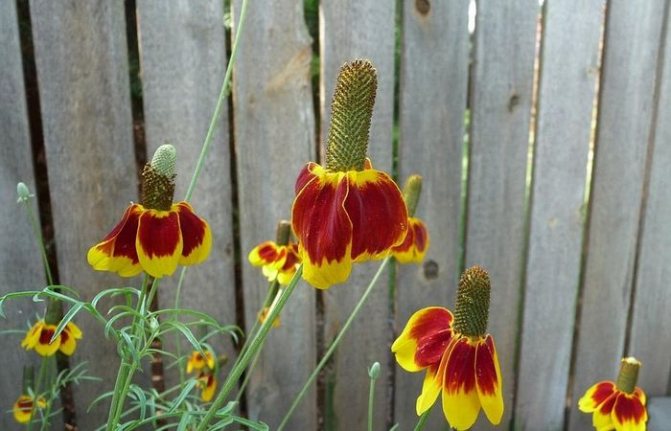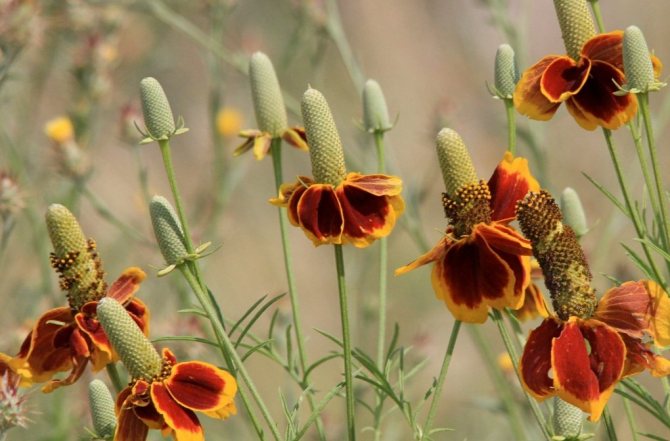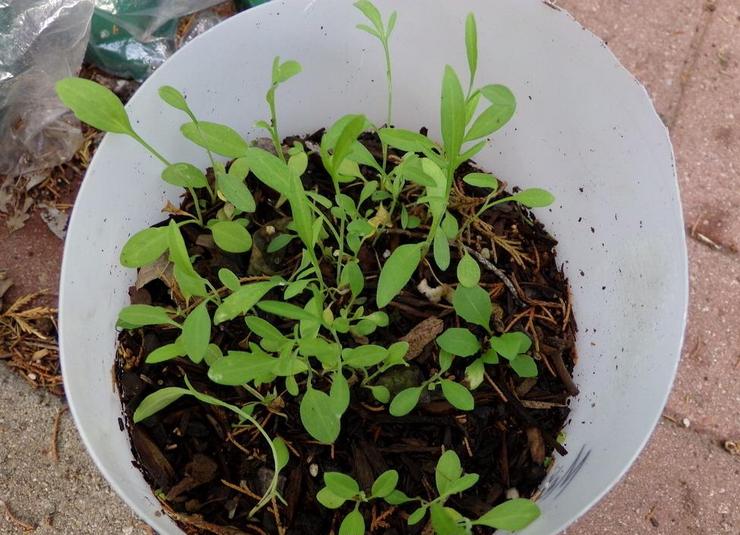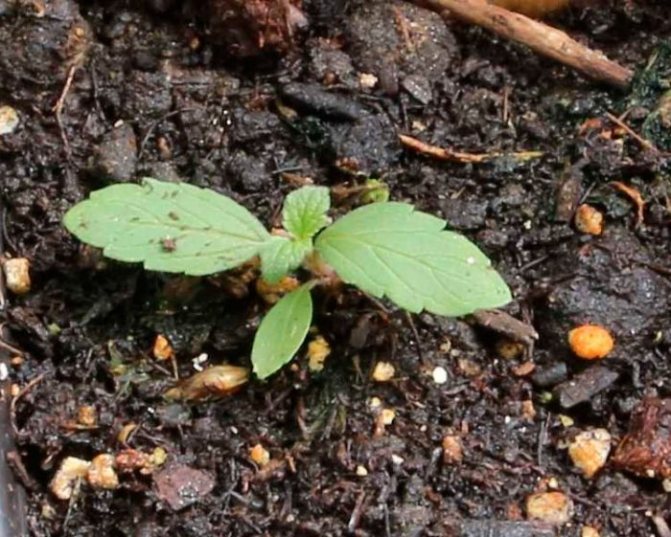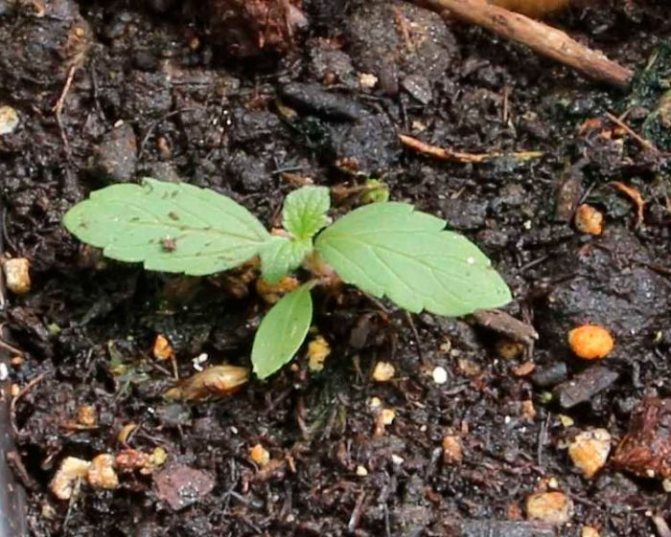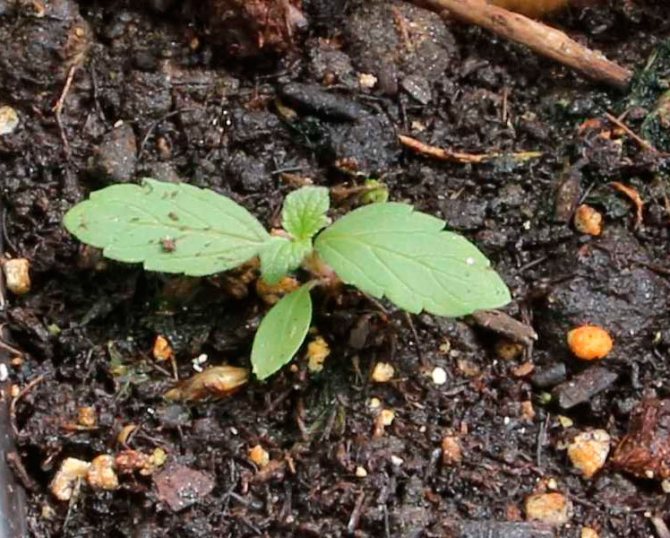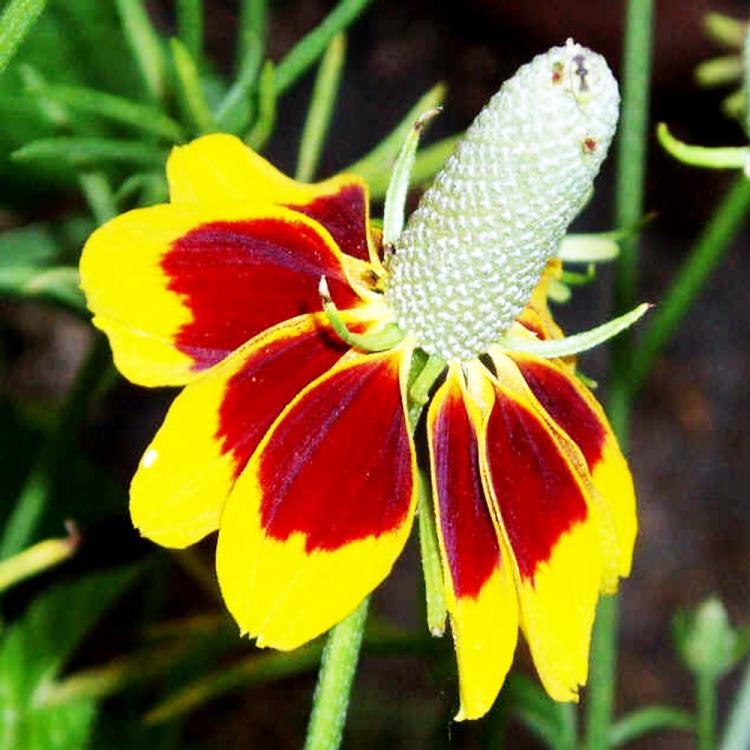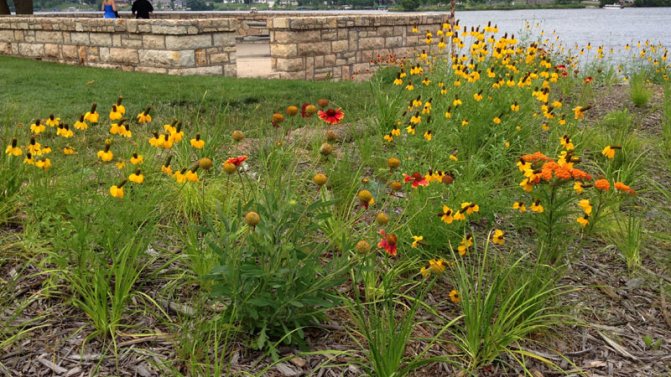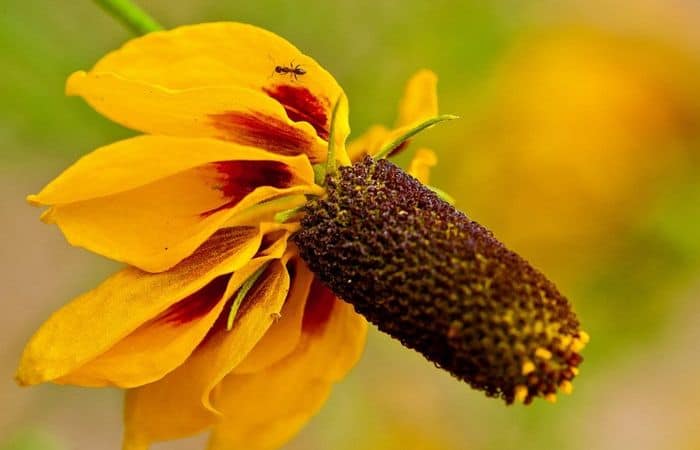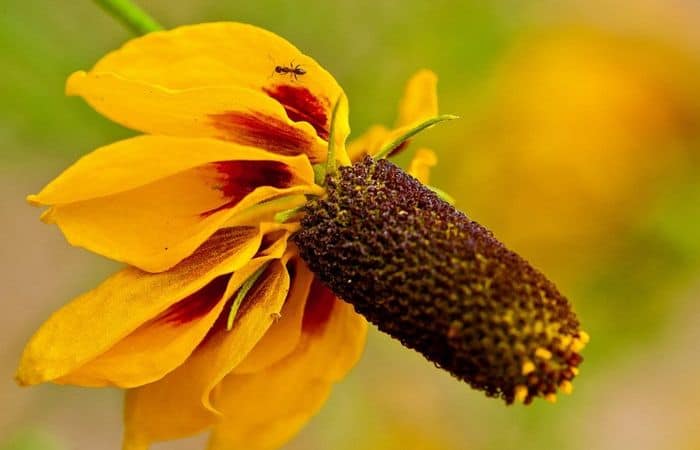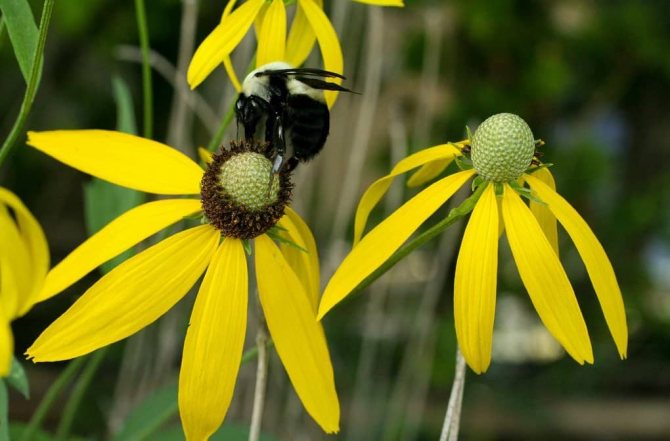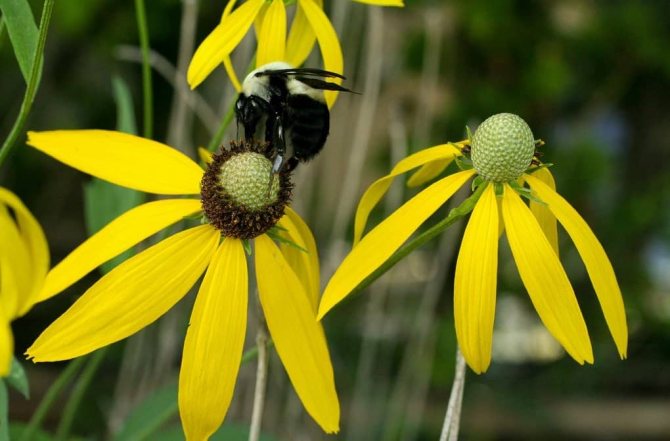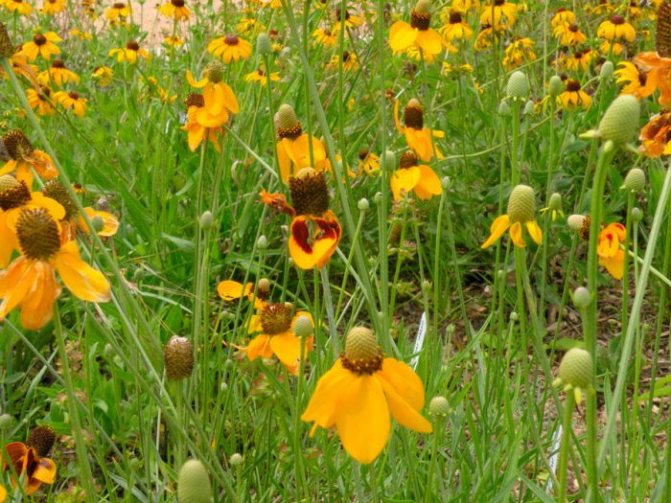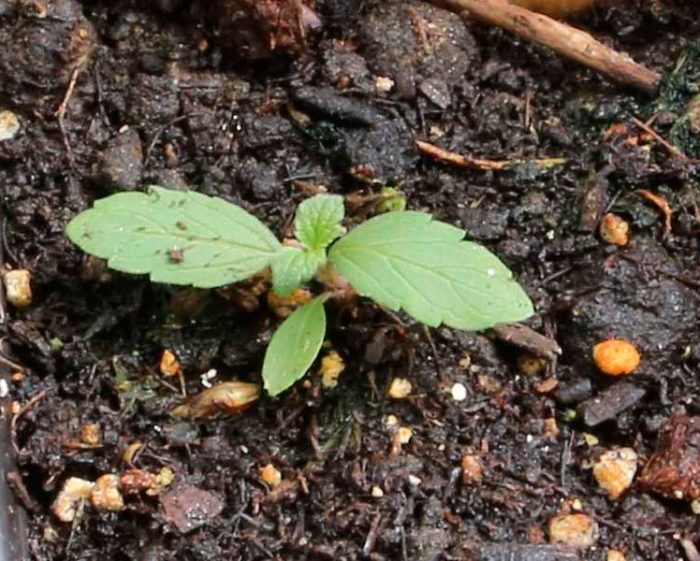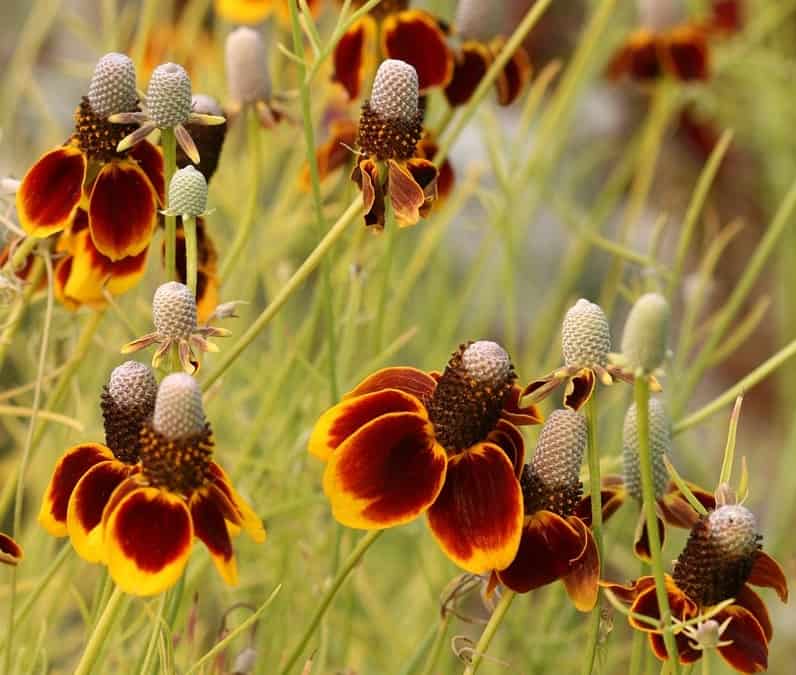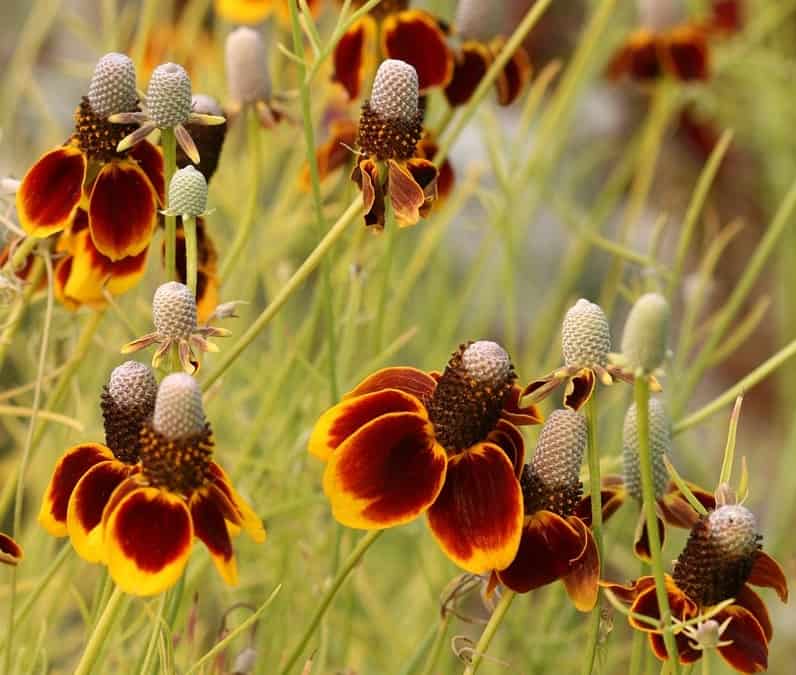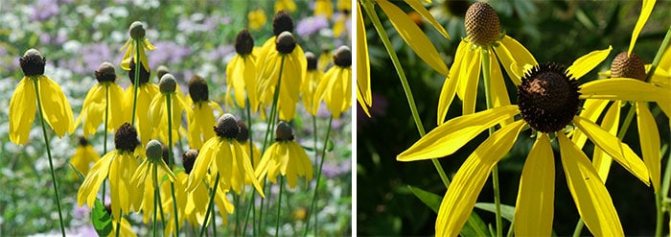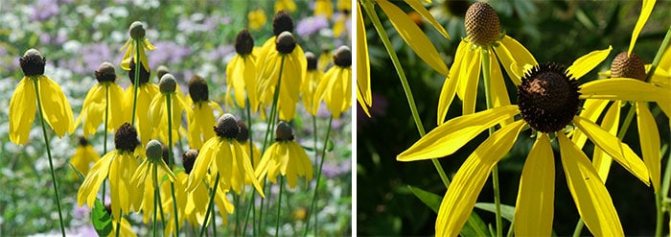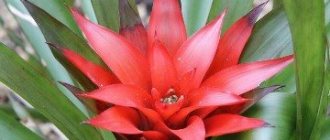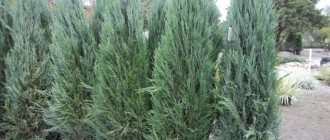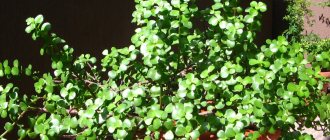Recently I visited friends and met a plant that won me over with its bright color and unpretentiousness. Of course, I have allocated a small area in the flowerbed for this exotic guest.
I want to share with all the rules of growing and caring for ratibid columnar. I hope that such a rare plant will gain popularity among our florists and become popular in our area. I am attaching a photo and video so that you can familiarize yourself with this original flower in more detail.
Features of ratibide
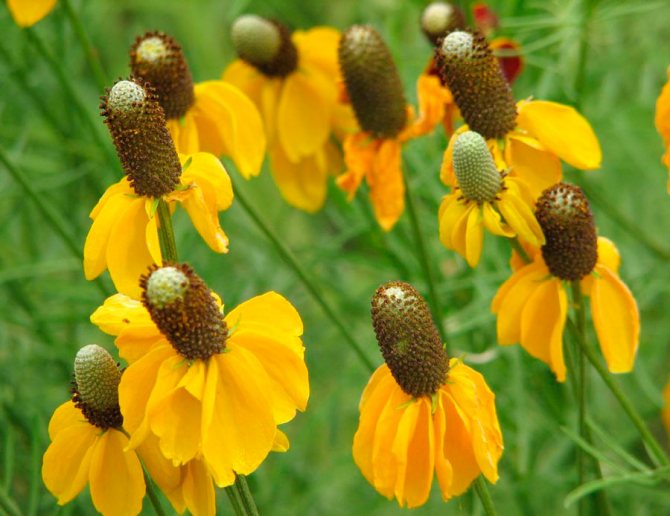
The genus of ratibid is represented by annuals and perennials. There is pubescence on the surface of the aboveground part of the bush. Branched, erect, leafy shoots have a rough surface, and their height can vary from 0.3 to 1.2 meters. The root system of such a plant is a branched rod system. The length of deeply divided leaf plates is 3–15 centimeters, they are colored greenish-gray. The inflorescences-baskets of such a plant are outwardly similar to the flowers of rudbeckia. Their cone-shaped center, which includes tubular flowers, reaches about 10 mm in diameter, it sticks up by 20-30 mm, and ligulate radiant flowers with a length of up to 30 mm hang down from its dark base. The reed flowers can be brownish-red, yellow, brown, brown with a purple border and red with a yellow border. The opening of the middle flowers occurs gradually from the bottom up and after only half a month the height of the cone can reach 40-50 mm. The fruit is a winged achene, which is about 0.4 cm long.
Ratibida columnar prairie flower. Ratibida - a guest from the Mexican prairies
Ratibida appeared in the proposals in the catalogs of seeds of various MIs relatively recently and is not yet particularly familiar to connoisseurs of flower beds and flower beds. I tried to grow it from seeds about three years ago, I liked it :-), tk. it is unpretentious, drought-resistant, winters well, and is not aggressive in our zone. So far I have only two color options, I saw another one on sale and all three appear in catalogs on. The other day I ordered the third color option there :-) Most of all I like brown ratibid - it has such a warm rich color and the petals seem velvety. I bought it in the version of the name from the Russian garden - "Mexican hat", now you can buy the same one from SeDek, called :-)), only it is lower (up to 50 cm), but my beauty is up to 100 cm high. Yellow is no less beautiful , only looks more delicate.
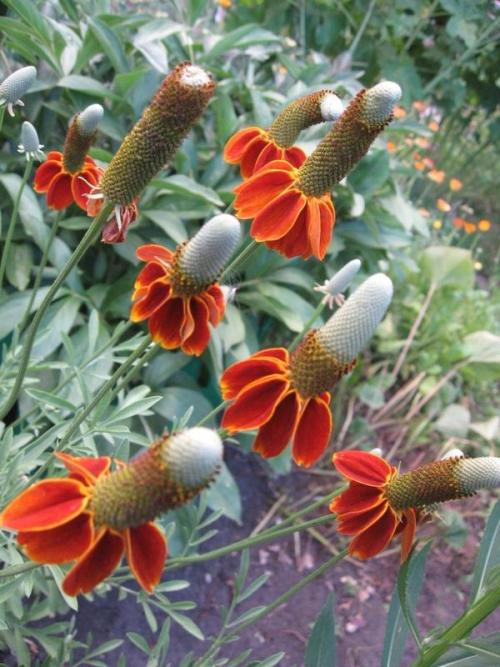

Ratibida columnar
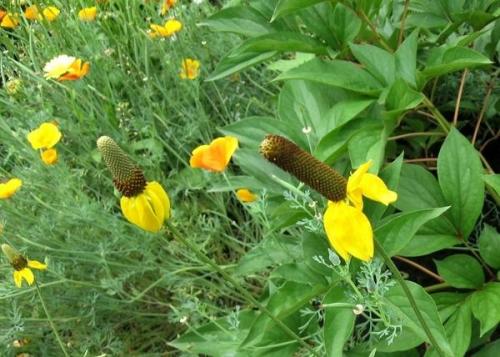

Ratibida columnar Prairie Flower
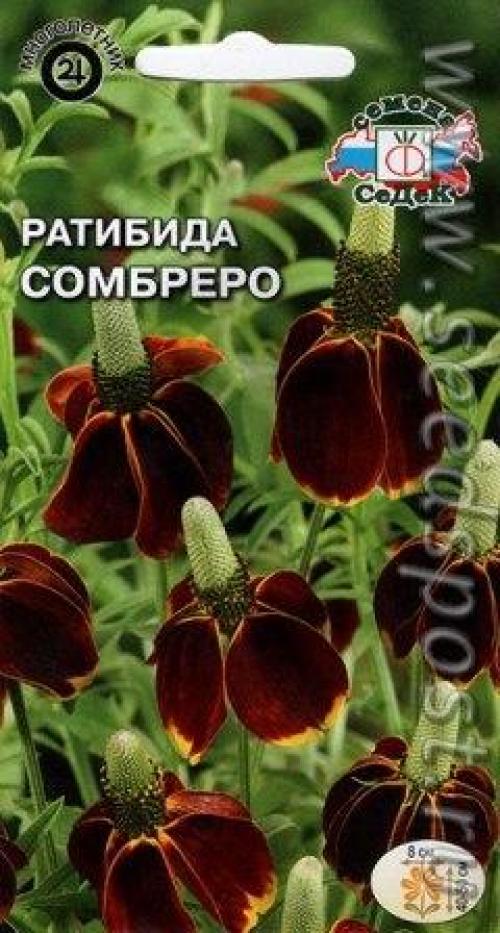

The plant is 40-50 cm high. The leaves are grayish-green, fleecy. Inflorescences are large, up to 8 cm in diameter
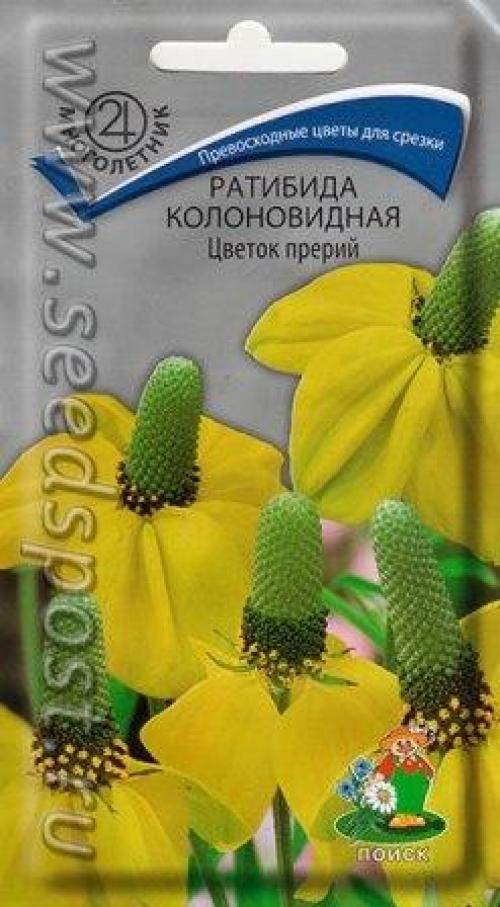

Plant height is about 60-70 cm. Leaves are grayish-green, fleecy. Inflorescences of unusual shape, large up to 8 cm in diameter
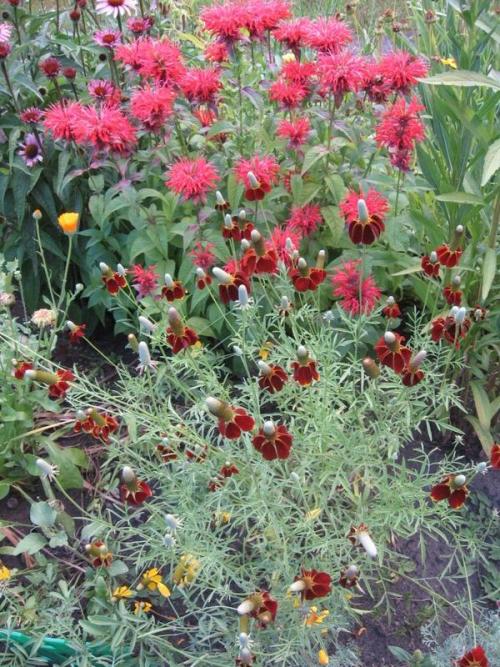

It is better to plant this beauty in sunny places, do not overfill. Therefore, in mixes it is better to combine with plants that do not require frequent and abundant watering.


The plant is clearly not from the group of dominants in the flower beds. But I saw pictures of ratibid arrays on the net - it looked very good.
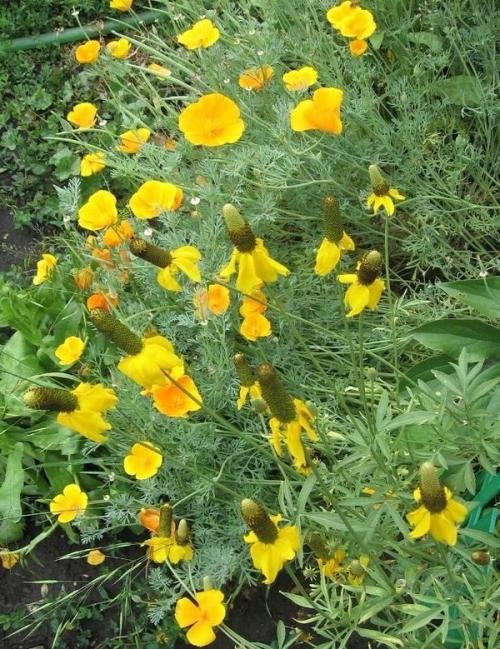

As far as I have found out, there are no more than ten perennial species of ratibid. But in our seed shops I saw only a columnar one.An interesting variegated color was offered by the Poisk company and I purchased the seeds in -.
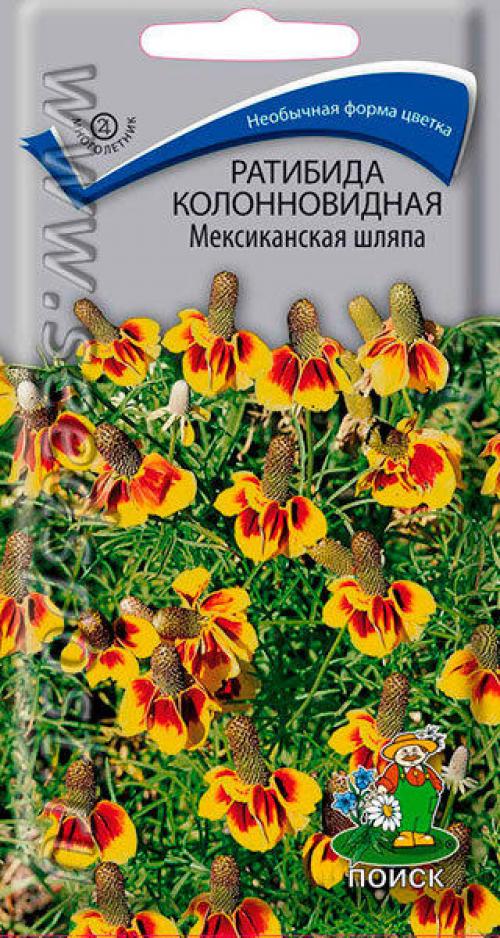

Plant height is about 60-70 cm. Leaves are grayish-green, fleecy. Inflorescences of an unusual shape, large up to 8 cm in diameter, ligulate flowers are yellow-red, tubular - brown-black in the form of a tall cylinder. Blooms from July to October.
Growing from seeds
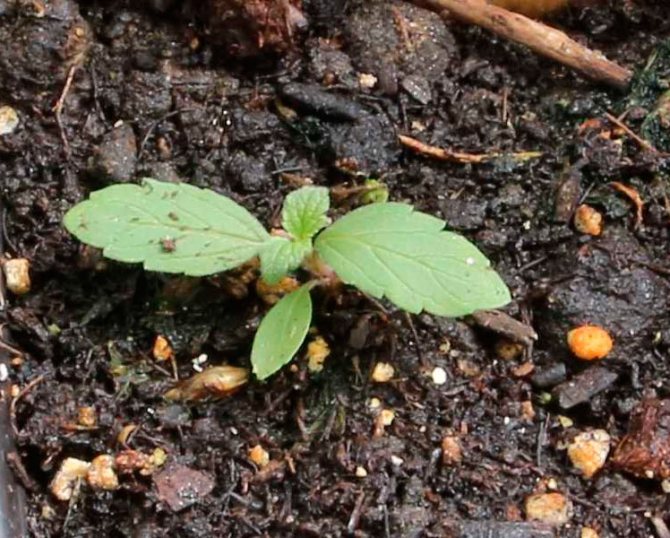

The ratibide is propagated by seeds and they do it both through seedlings and by the non-seedling method. Sowing seeds in open soil can be carried out in late autumn or early spring, when the ground has not yet thawed completely. If sowing is carried out in autumn, then seed material does not need pre-sowing preparation. It's just that not very deep grooves are made in the prepared area, and then the seeds are evenly distributed in them, they should be covered with a layer of sand on top and covered with spruce branches. When sowing in spring, seed material will require mandatory preliminary cold stratification. To do this, it is placed for 4 weeks in a place where the air temperature is kept within 0-5 degrees.
However, the most popular among gardeners is the seedling breeding method of ratibid. Seeds are sown for seedlings in winter, or rather, in mid-February. Peat cups should be chosen for sowing, because seedlings react extremely negatively to both picking and transplanting. To fill the cups, a moist and light soil mixture is used, which includes coarse sand, turf soil and peat (1: 1: 1). The seeds do not need to be buried, they are simply pressed into the surface of the soil mixture, and the container is covered from above with glass (film). Then the crops are transferred to a well-lit place, where it is always warm. The first seedlings should appear after about half a month, after which the shelter is removed, and the plants are provided with a large amount of bright sunlight, which must be necessarily diffused.
Clarkia is a lovely godetia. Clarkia genus (godetia) - Clarkia Pursh.
General characteristics . The name of the genus is given in honor of Captain William Clark, (1770-1838), who accompanied the famous American traveler Captain M. Levis on an expedition that explored the Rocky Mountains in 1806.
Annual herbaceous plants. Stems are erect, less often to prostrate, branched, slender, more often short-pubescent. Leaves are alternate, usually lanceolate or linear, whole or finely toothed, sessile. Flowers are solitary in leaf axils, sessile, forming leafy racemose or spike-shaped apical inflorescences. The flower tube (hypanthium) is inversely conical, funnel-shaped, bell-shaped or narrow, cylindrical, usually with a ring of hairs inside. Sepals, 4 in number, bent, loose or accrete at the base, often red. Petals, 4 in number, obverse-lanceolate to obovate, narrowed at the base into a marigold or - in species previously distinguished as a separate genus of godetia (Godetia) - almost without marigold, solid at the apex, notched or often trilobate. Stamens, 8 pieces, located in two circles or when reducing one circle in the number of 4 pieces. The capsule is elongated, four-celled, polyspermous. Blooms in July-September.
33 types. West of North America, South America.
The history of culture and the degree of distribution. In culture since the beginning of the 19th century. In ornamental gardening, 9 species are used. Widespread.
Features of cultivation. Photophilous, but can grow in partial shade. Moisture-loving, prefers constantly, but moderately moist areas. In dry and hot summers, regular watering should be ensured to avoid loss of decorative effect or complete cessation of flowering. It does not tolerate prolonged waterlogging and stagnation of moisture on poorly drained heavy soils, but prefers a cool and moderately rainy climate.Not too picky about fertility, it can grow on ordinary drained garden soils, moreover, on excessively fertile and moist soils, the bush loses its compactness, develops abundant vegetative mass and lays down. It is advisable to plant on loamy soils that retain water well and provide good drainage. The transplant is well tolerated only at an early age. It is recommended to pinch seedlings at a height of about 10-12 cm for a denser tillering and abundant flowering. Tall species and varieties need a garter for light support. Cold-resistant up to minus 5-15 ° C, depending on the type.
Reproduction methods. Seeds that are sown for seedlings in early April or directly in open ground in spring or early summer. Unfortunately, open field seeding is problematic due to severe damage from earthen flea beetles. Seedlings appear in 8-10 days. Plants bloom two months after sowing.
Use. Beautifully flowering unpretentious annual herbaceous plants, forming graceful pyramidal bushes with numerous, dense clusters of silky, bright, simple or double large flowers. It is most often used for borders in flower beds and ridges, as well as near shrubs, for mixborders, but it is most attractive when planted in a solid mass. One of the best cut flowers.
Decorative views.
Decorative varieties.
Planting and caring for ratibid in the garden
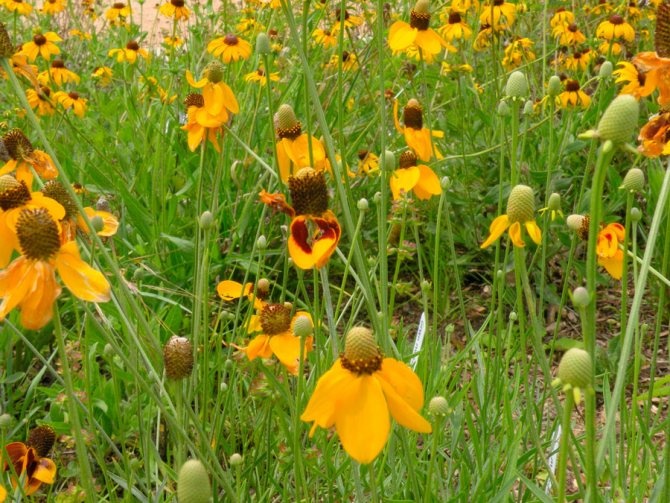

Care features
Planting grown and matured ratibid seedlings into open soil is carried out after the threat of return spring frosts has been left behind. However, when 15 days remain before transplanting, the seedlings need to be hardened. To do this, they are transferred every day to fresh air (terrace, balcony or garden), the duration of such a procedure should be increased gradually, starting from several hours, while for hardening, you need to choose a place that will have reliable protection from drafts and precipitation.
An area suitable for growing such flowers should be well lit or slightly shaded. And the soil should pass water and air well and it is best if it is loam or clay soil. Ratibida has good tolerance to slightly acidic, slightly alkaline or slightly saline soil. Before sowing, the site must be prepared; for this, it is digged, during which 1 tbsp is introduced into the ground. wood ash and 10 liters of compost per 1 square meter.
For planting seedlings, it is recommended to choose a cloudy day or evening. A distance of at least 25 centimeters is maintained between the landing pits. It is necessary to plant the bushes together with an earthen lump, and if it grows in a peat cup, then the planting is carried out with it.
In the first year of growth, the bushes rarely bloom; this can only happen in a very hot summer, shortly before autumn. As a rule, many gardeners cultivate such a flower as an annual, but it can be grown outdoors for 3 years. At the beginning of the spring period, the bushes are removed from the soil, after which they are divided into parts. Delenki are planted in separate pits in a new area. If the transplant is not carried out, then at the beginning of the growing season the shoots of the bushes will become woody.
How to water and fertilize
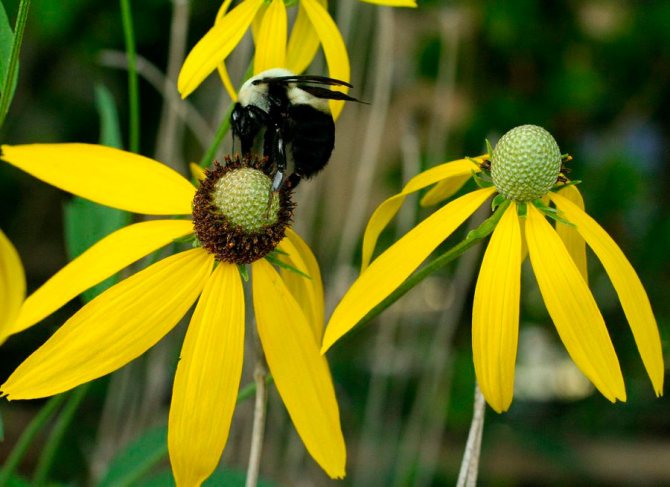

It is quite easy to grow ratibida in your garden, besides, it reproduces well by self-seeding. In order to exclude the possibility of uncontrolled reproduction of such a culture, it is necessary to promptly cut off the inflorescences that have begun to fade.
Such flowers need watering only during a prolonged drought, for this they use water that has settled well and warmed up in the sun. If it rains systematically in the summer, then additional watering of the ratibide is not needed. When the bushes are watered or it rains, the surface of the soil on the site must be loosened, at the same time all weeds should be removed.
Such a plant does not need feeding, all the more if it is grown in nutritious soil, the fact is that it has a tap root, which can extract nutrients from deep soil layers. If the soil contains a lot of nutrients, then this will cause the active growth of green mass, which will have an extremely negative effect on flowering.
Diseases and pests
Such a flower is distinguished by a very high resistance to harmful insects, and it is also very rarely affected by a variety of diseases. In some cases, during prolonged rains, the bushes can rot, in this case it is recommended to dig up the affected plants, and the soil where they were grown is treated with a solution of a fungicidal agent. Also, in some cases, a whitish bloom forms on the surface of the aboveground part of such a plant, which indicates its defeat by powdery mildew. Sick bushes are treated with a solution of soda or a fungicide containing sulfur, they are sold in a special store. If the bushes are very strongly affected, then it is better to remove them from the soil and destroy.
Ratibida (Mexican hat): cultivation
Many housewives would like to decorate their flower beds with an unusual flower. They have a huge choice. Ratibida has been cultivated for several centuries, since about 1811. But for us this plant is still exotic. Mexican hat - the name is very colorful, and gardeners think that the plant will be a lot of trouble. But this is not the case. Ratibida is columnar unpretentious, only decorativeness and splendor of the bush will depend on the quality of care, but the plant itself will not die.
It is best to plant ratibida in the flower beds on the sunny side. The place should warm up well. This plant does not like shading. It is advisable to plant the North American beauty in limed soils with an acidity of about 7.5.
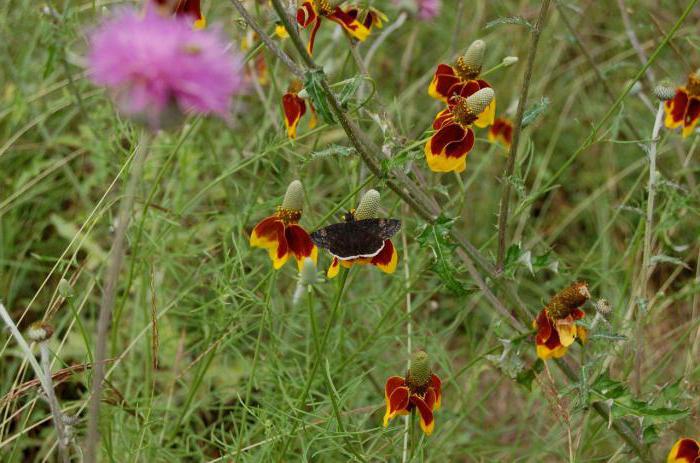

The place for planting ratibida is being prepared in the fall. Loose dolomite flour mixed with sand is added to the soil. Poor soils are suitable for the plant, as long as it is not clayey. Fertilized soil, however, guarantees a lush bloom. The Mexican hat does not require any special care. It tolerates low temperatures and drought well. Watering ratibids is carried out to prolong flowering. Ratibide is resistant to garden pests and various diseases.
The only problem is the fight against self-seeding. The Mexican hat grows well, and if there is a possibility of crushing neighboring plants, the excess self-seeding should be removed.
Main types and varieties
Ratibida columnifera
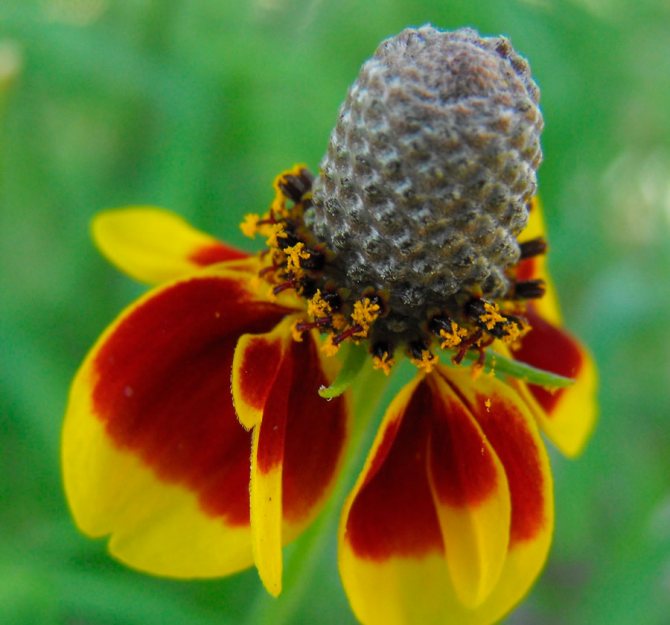

In addition to the elongated or columnar ratibid (Ratibida columnifera), which was described in detail above, another species is cultivated by gardeners.
Ratibida pinnata (Ratibida pinnata = Rudbeckia pinnata)
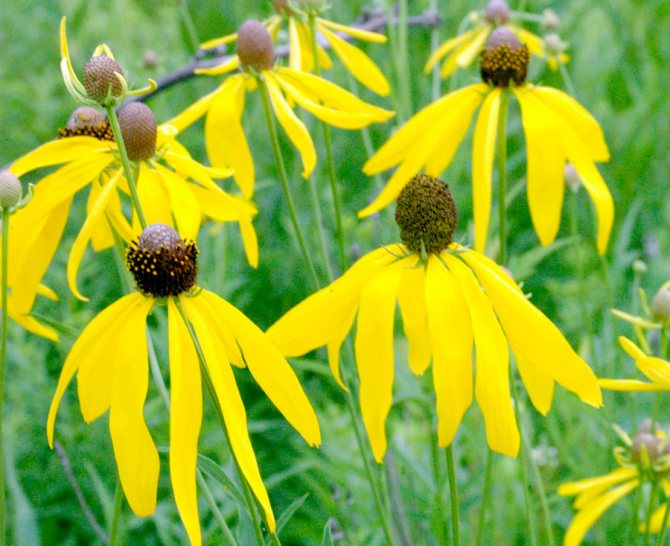

This perennial is native to North America. The convex middle of a dark bronze shade consists of tubular flowers, and around it are ligulate flowers of a deep yellow color. During opening, the disc is greenish-gray, but gradually it turns brownish-black. Bushes reach a height of 1.2-1.5 meters. The shoots are hairy and tough, and the pinnate leaf plates consist of 3–7 toothed lance-shaped segments. This type is distinguished by its unpretentiousness and resistance to frost, drought, disease and harmful insects.
The elongated ratibide has quite popular varieties and varieties:
- Pulcherrima - the color of the petals is wine-red, they have a yellow border;
- Yellow Cheyenne - ligulate flowers of a rich yellow color;
- Red Midnight - marginal flowers of a dark red hue.
A little about the discoverer
The first description of the flower was made by an American naturalist. This person's name is not easy to remember. His name was Constantin Samuel Rafinesk-Schmalz. This scientist was engaged not only in zoology and botany, but was an expert in the field of meteorology and anthropology. He was also a geologist and linguist.The life time of a scientist is 1783-1840.
Rafinesk-Schmalz was a genius of his era, but many considered the scientist to be a madman. Studying the vegetation of North America, he had a chance to describe at least 250 new species, but the scientist came up with very strange names for many of them. An example of this oddity is the ratibide plant, which has a simpler name - the Mexican hat.
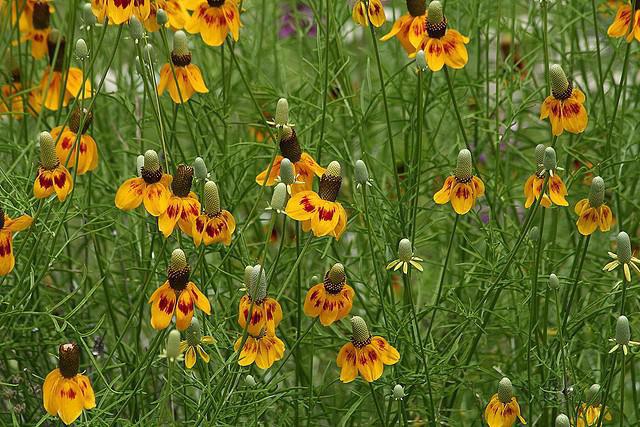

Basic description of the ratibide
Unfortunately, this plant is rarely found in our flower beds and flower beds. It's a pity, because it is very original and unusual, and can decorate any garden plot.
In addition, ratibida is so undemanding and unpretentious that even a novice florist can grow this bright flower.
This flower is popularly called the "Mexican hat". And, indeed, it resembles the headdress of the Mexicans. They refer it to the Asteraceae or Astrov family.
The name was given in the first half of the 19th century by the American naturalist KS Rafinesk - Shmalts. He discovered this flower, described and gave such an unusual and exotic name. It is a perennial herb.
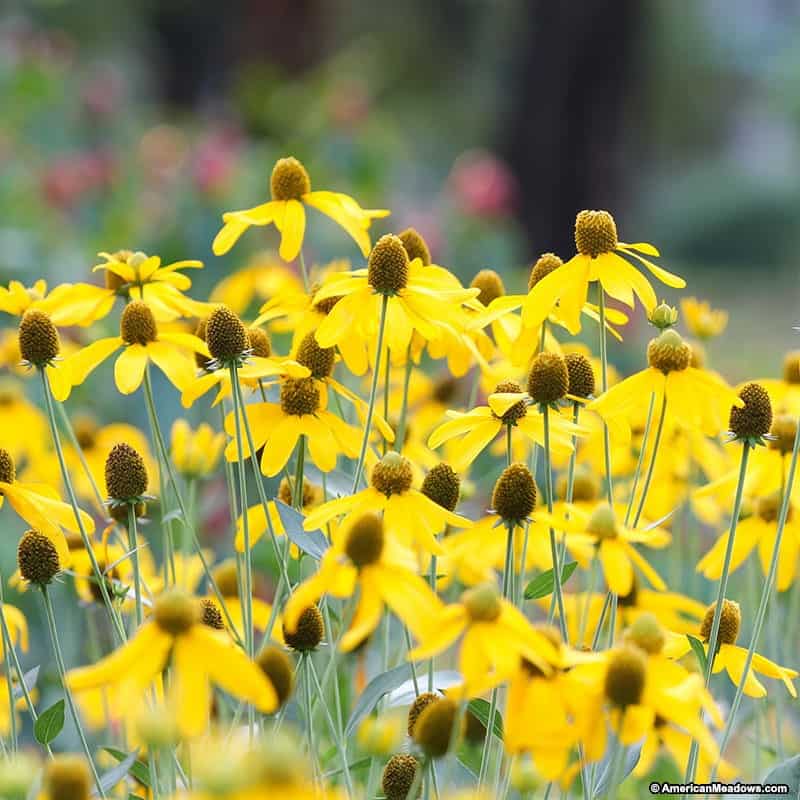

The homeland is considered to be North America. And under natural conditions, ratibid grows over a vast territory - from the Mexican prairies to Canada. Places of its growth can be called both wastelands and meadows, and thickets along the roads.
- The core of this flower is strongly elongated, and elongated (up to 3 cm) petals are located around. Their color can be yellow, bright red with a yellow rim, burgundy, yellow-orange.
- Stems are often solitary in shape, less often branched, rigid.
- The height of the bush can reach more than one meter.
- The leaves are narrow, lanceolate, rarely grow on the stem. Their color differs slightly, depending on the variety: sometimes the leaves are bluish-green with a slight grayish dusting, and sometimes they are bright dark green in color.
All the beauty of this plant lies precisely in the uniqueness of the flower. Ratibida perfectly tolerates both the scorching rays of the sun and drought and frost. In nature, it reproduces by self-seeding.
Novice growers can safely grow this plant, because it does not require any special worries.
Spread
The homeland of the Mexican hat is North America, the distribution area stretches from the southern territories of Mexico through the western regions of the United States to northern Canada. Ratibid, unpretentious to growing conditions, is found in the mountains, and on the plains, in the desert prairies. Neighboring a person, a flower can settle near noisy roads, along railway embankments, on wastelands, around dwellings.
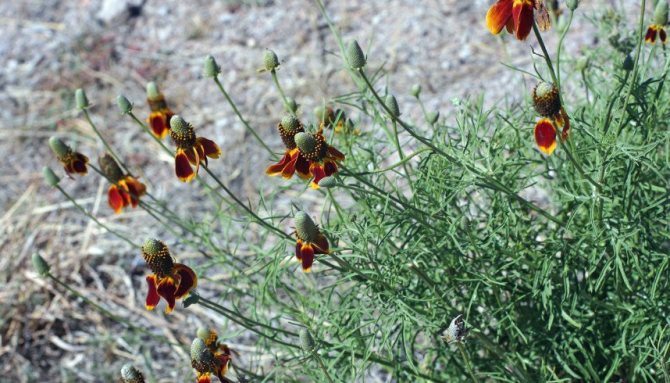

Did you know? Naturalist Samuel Rafinesque, who discovered ratibida, made a significant contribution not only to the study of the flora and fauna of the continent, but also to the study of the culture and life of the ancient North American peoples. It was his work that gave impetus to the study of the writing of the Maya Indians.
Common varieties and types
Of the seven species known in botany, only 2 are the most popular. Let us dwell on each one separately.
Ratibida columnar
It has a second name - columnar rudbeckia. This type is distinguished by a protruding and elongated core. The flowers are large, up to 8 cm in diameter. Stems and leaves are tough, slightly pubescent, gray-green in color. The height of the bush reaches a meter in height.
Several varieties are known that are most often found in flower beds:
- Ratibida is Beautiful. It differs from the others in two-color petals: the middle of the petal is crimson-red, and the edging is yellow. The contrast gives the variety a showiness and originality.
- Cheyenne yellow. This variety is beautiful for its delicate yellow petals, which attract with their interesting shape and pure bright shade.
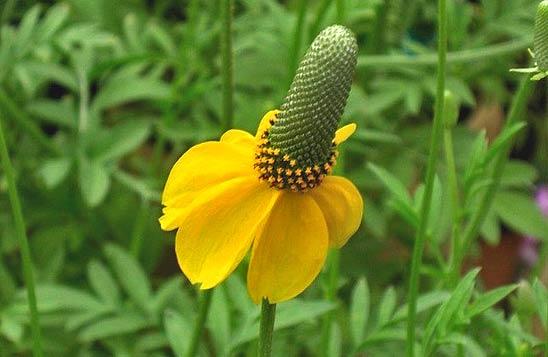

- Red midnight. The tone of the petals is absolutely magical - deep purple with a burgundy hue. It is simply impossible to pass by.
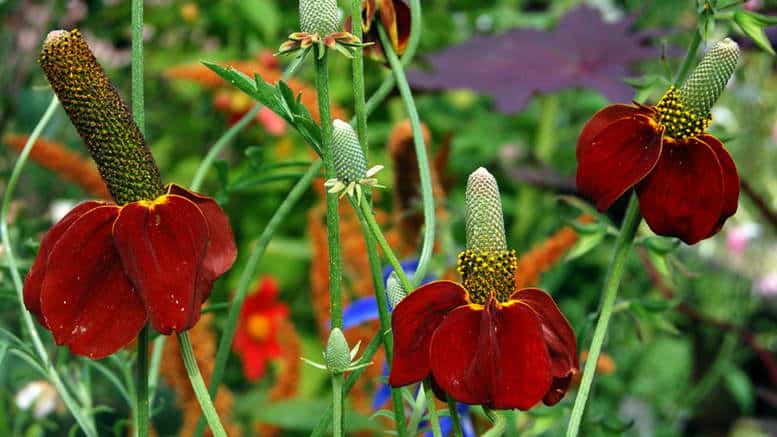

Ratibida pinnate
This view is somewhat different from the previous one. The core is not cylindrical, but wide and slightly flattened. And the petals are narrow, yellow in color and have a faint aroma of anise. This type of bush stretches up to 1 - 1.2 m.
Description of the flower
The first mention of this flower dates back to the beginning of the 19th century. It was discovered by the American naturalist KS Rafinesk-Schmalz during one of his scientific expeditions to the Great Plains. The scientist carefully studied the plant, described and named it.
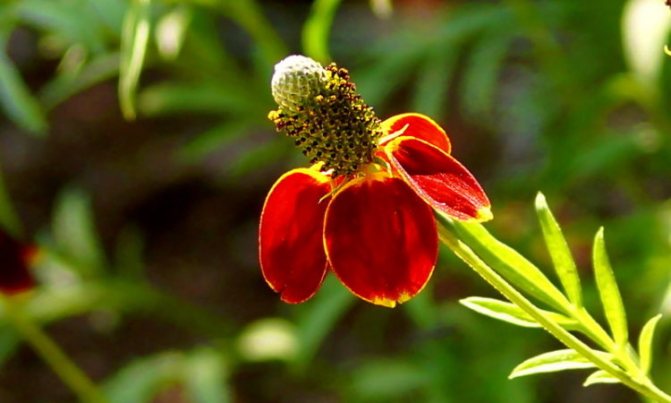

What a ratibide looks like
For your information! The ratibid flower for its resemblance to the headdress of the indigenous Mexicans acquired the popular name "Mexican hat" or "sombrero". This similarity is due to the overly convex core and bright edging of burgundy or yellow petals.
Straight, with sparse branches, flower stems are covered with small lanceolate leaves, which, depending on the species, can be either silvery green or dark green.
Habitat
The natural habitat of this spectacular plant is very extensive: from the cool hills of Canada to the hot prairies of Mexico. This means that the Mexican hat can tolerate dry and dry as well as cool climates.
Common types
Ratibida sombrero cannot boast of outstanding species diversity. Today, 7 species are known, of which two are most popular: columnar ratibid Conflover and pinnate ratibid.
Ratibida columnar Conflover is the most famous and widespread plant species with large flowers. In diameter, they can reach 8-10 cm. The stem is very hard, slightly pubescent, the leaves are sparse gray-green. The stems of this flower can grow up to 1 m in length.
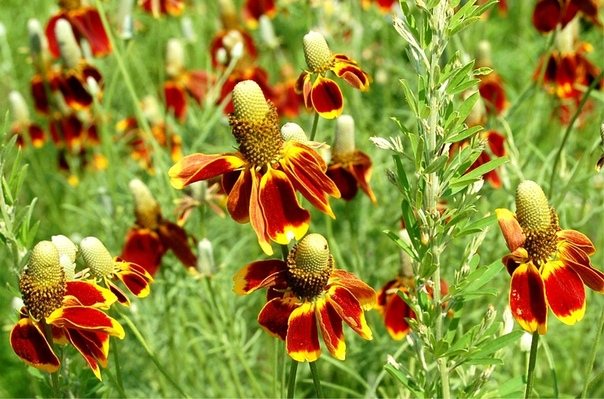

Ratibida columnar
On the basis of the wild species of ratibids, breeders managed to develop a sub-variety, which were named fine ratibid (var. Pulcherrima), Yellow Cheyenne ratibide, Red Midnight ratibide.
Cirrus (Ratibida pinnata) is distinguished by elongated petals and a modest spherical core. The flower is very similar to rudbeckia and is often confused. In addition, the stems of the pinnate ratibide are much longer than the columnar ratibide and can reach 1.5 m.
Planting and care rules
Ratibida is a very hardy plant. She is able to adapt to almost any conditions. Although there are some recommendations. There is nothing difficult in leaving - it is periodically necessary to loosen the soil and remove weeds.
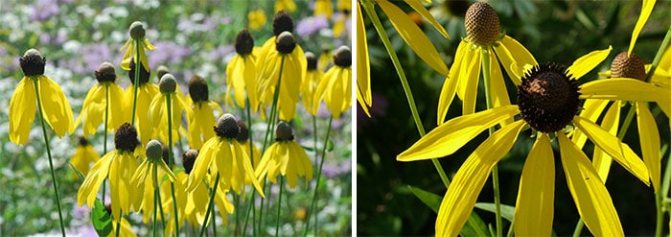

Choosing a landing site
Ratibide looks best in group plantings, stylized as a meadow. Since the plant is very hardy, you need to choose the same neighbors so as not to overwhelm. It will get along well with pachisandra, dragons, rudbeckia, echinacea, chamomile, clover.
It stands out beautifully if planted along the paths. A single bush is not often planted due to the structure of the stems and rare leaves.
- Loamy alkaline soils are preferred. It often grows in limestone and even rocky places.
- It is best to find a dry planting site that is well drained. It is not advisable to plant in swampy or damp areas with high flowing groundwater. It is worth avoiding stagnation of water in the soil. The plant may die.
- You need to choose a place well lit by the sun, in extreme cases with diffused light or partial shade. Landing in dark, shady places with drafts and gusts of wind is not recommended.
Since flowering lasts almost the whole summer and early autumn, ratibida is often grown for cutting. In flower arrangements, it can keep its fresh appearance for about 7 days.
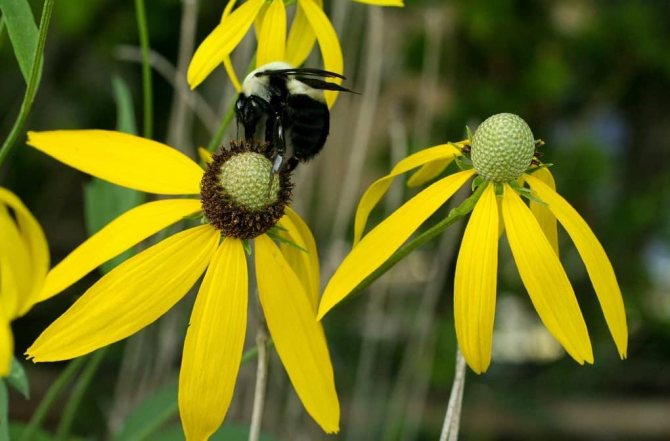

Planting with seeds (seedling method)
Since the plant is perennial, it can be propagated by cuttings, dividing the bush and seeds. If the climate is severe enough and characterized by cold and frosty winters, then the seeds can be planted in advance for seedlings.
- At the end of winter, the seed must be stratified.To do this, place in a cold place for a month. Cold hardening will help the seeds germinate faster.
- You can make your own planting mix. Sod earth, peat, sand and perlite are mixed into a homogeneous substance.
- They moisten the ground a little and after that the seeds are not buried deep into the ground, but only a little bit, practically leaving them on the surface. Ratibida loves the sun.
- The root system of the plant is rather fragile, so it is not recommended to sow seeds for seedlings in a large container. It is better to plant them immediately in separate pots or in peat pots, which are then simply planted in open ground.
- Sowing seeds in the ground, then cover with foil. It must be opened periodically to ventilate. The room temperature should be at least 20 - 25 degrees Celsius. The soil should be moistened as necessary. Do not let the soil dry out.
- After 7 - 14 days, the germinated seedlings are transferred to open soil. The site needs to be prepared in the fall, after digging it up. Wood ash (200 g per 1 m2), compost (bucket per 1 m2), dolomite flour are added to the soil. And also, if possible, a little lime and river sand will not hurt either. Such a mixture will make the soil fertile, fertilized and able to pass air and moisture well.
- If the place is damp, then a drainage layer in the form of broken brick or gravel is made under the beds.
- Then the seedlings with a lump of earth or in peat tablets are transferred into pre-dug holes, the distance between which is at least 30 cm.
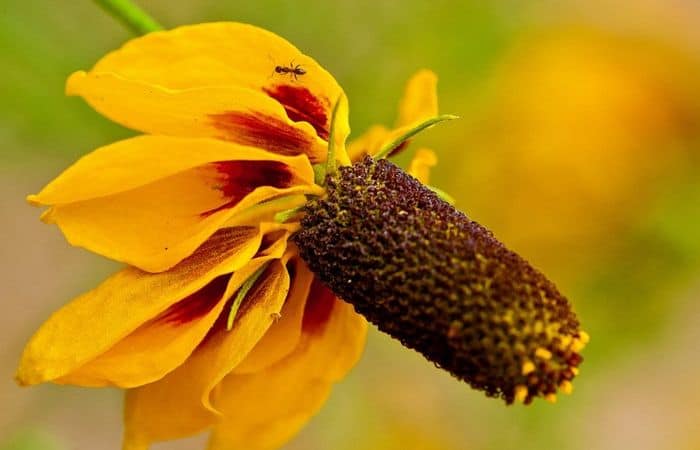

At night, it is necessary to cover young shoots for some time until they are sufficiently strong. Flowering can be observed already at the end of summer or as early as next year.
Planting seeds in open soil
This method is also possible. The advantage is that you do not have to disturb the root system, but immediately sow the plant in a permanent place. Planting is carried out either in the first decade of April or at the end of autumn. In the southern regions, seeds can be planted at the end of winter.
- The soil is also harvested. Seeds are planted in pits up to 2 cm deep and at a distance of about 30 cm between each other.
- Seeds should be lightly sprinkled with river sand and covered with a small layer of spruce branches.
- In the spring, they are planted immediately in the ground after the snow melts. In this case, they simply distribute the seed material on the surface of the soil and sprinkle it with a layer of earth or sand.
- Watering should be moderate. The main thing is not to allow the soil to dry out. Seedlings can be thinned out.
The first bloom will come in early summer. Remember to periodically loosen the soil and remove weeds.
Cutting method
This method is used very rarely, because the seeds germinate well. For such a procedure, a lateral shoot is cut off near the root itself and stuck into the prepared soil. Cover the top. The shelter is removed when, after a while, the cutting has its own root system.
The stalk is deepened to a distance of no more than 3 cm. The soil is well moistened before planting.
The method of grafting is carried out before the flowering process - in late spring or in the first half of June.
Such a procedure may not give positive results, because the root system of the ratibid is fragile. If the root is damaged, the flower may die. But if you nevertheless decide to try, then this method is appropriate only once every few years.
The division of the bush is carried out either at the beginning of spring, or at the end of the autumn period. Be extremely careful with the root system.
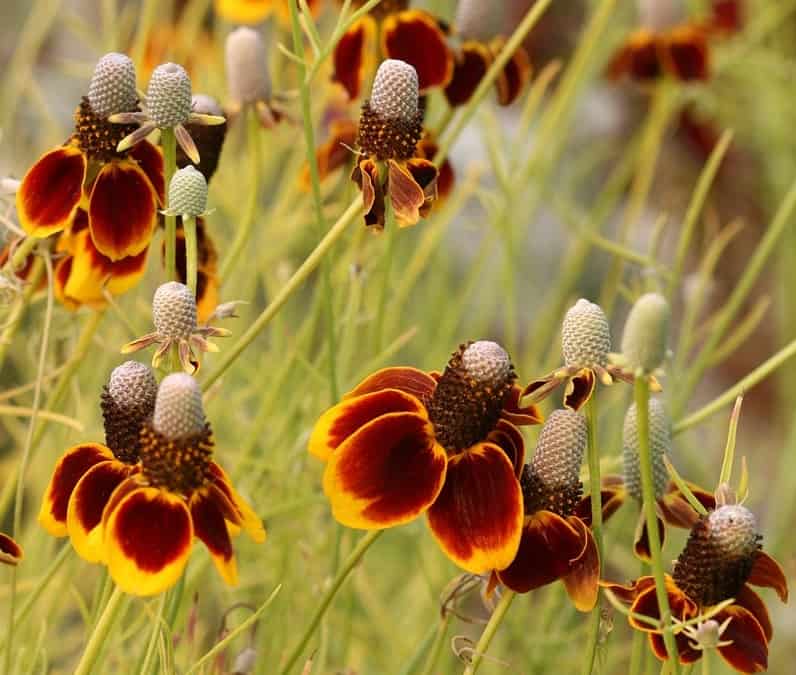

Watering and feeding ratibids
Water the plant as needed. It will be appropriate after loosening the soil. The main thing is to prevent drying out and excessive waterlogging of the soil.
Ratibid is fed no more than several times a year. Be sure to fertilize after planting seedlings in open soil. And you can support the plant during the period of bud formation. It is better to use mineral fertilizers.
Gem
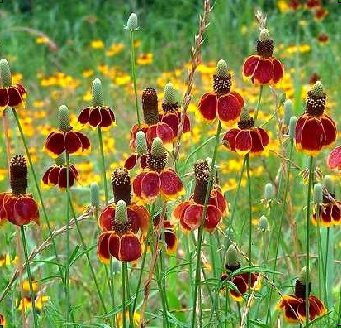

Yesterday my wife bought some flower seeds.Among them was an unfamiliar plant: columnar ratibide Sombrero. The picture looks very nice. I looked what about these flowers are in the books. Found nothing. I had to search on sites on the Internet. I looked through a dozen and a half. As a result, we got such a collection of information.
This perennial herb belongs to the Asteraceae family. How many species I have not found in the genus. There are no plants in the Russian-language Wikipedia, only in the English version there are several lines. In horticulture, two types are used: columnar ratibid (Ratibida columnifera) and pinnate ratibid (R. pinnata). Both grow in the wild on the prairies of North America. Columnar for the appearance of inflorescences is also called a Mexican hat. Our bag says Sombrero. Apparently depends on the seed producer.
Ratibida columnar has a well-developed taproot system. One or several sturdy stems can reach a height of 130 cm. What we sell usually has a height of 40-70 cm. Leaves up to 15 cm long are grayish-green in color, fleecy. In the form of inflorescences, ratibids are similar to rudbeckia or echinacea. Only the cone of tubular flowers of a slightly different shape and larger echinacea. The cone of the ratibide is dark in color, it can be up to 3 cm in height and about 1 cm thick. The petals are turned down, the color is yellow. There is a variety with dark red petals with a yellow tip. The diameter of the inflorescences is about 8 cm.
Ratibida is pinnate with stems up to 150 cm high. The leaves are pinnate. Inflorescences with bright yellow petals and a bronze cone.
Both species bloom from July until late autumn.
The plant loves sunny places. The soil needs a well-drained, loamy, calcareous soil. It grows well on both slightly acidic and slightly alkaline. Ratibida is drought-resistant, so watering is needed only in dry weather. Top dressing is not required. When overfeeding with fertilizers, the plant begins to grow green mass, and the flowering worsens. She does not need shelter for the winter. It is resistant to diseases and pests. Well, the real daughter of the prairie.
The easiest way to reproduce ratibid is by seeds. Having planted it once, it will further multiply by self-seeding. It is necessary to sow seeds in open ground in the fall or early spring, in the ground that is still frozen. The fact is that the seeds need stratification within 30-40 days. Or you can sow seedlings in late February - early March with preliminary stratification. It is necessary to sow superficially, and then press down the seeds, or sprinkle a little with sand. Only young seedlings can be transplanted and always with a clod of earth. An adult plant does not tolerate transplantation and it is also not worth propagating by division due to the peculiarities of the root system. The spacing between plants when planting is about 20 cm.
Ratibida is used in rural style flower beds to create borders. It is necessary to plant in a group. Well worth a cut, up to 10 days.
Flower garden on the window. Beauty in the country.
Features of ratibide columnar
This type of flower belongs to the group of large plants with expressive buds. The native land of the columnar ratibide, or, as it is also called the "Mexican hat", is the lands of Mexico and Canada. But despite its origin, it develops well in our latitudes.
In its homeland, the plant is also referred to as:
- thimble;
- echinacea narrow-headed;
- the ratibide is long or columnar.
The flower belongs to the group of herbaceous plants. In nature, it prefers drier areas. Ratibida columnar is a flower that grows on the prairies and along highways. Often, the plant "settles" near abandoned houses and covers areas that have not been cultivated for a long time.
Cultivation of columnar ratibide began in 1811.
A distinctive feature of this culture is its elongated deciduous plates.They can be either feathery or divided. The lower leaves are grayish. They grow up to 16 cm in length, and their width does not exceed 7 cm.
The plant grows in the form of a bush with many spreading branches. On average, it reaches one meter in height. The stems of this variety are rough, slightly covered with fine hairs.
On adult plants, an arrow forms on which a bud is formed. The diameter of the columnar ratibide flower can reach 7 cm. Often, loose buds have a burgundy hue, but there are also those that are painted in a brownish-yellow tone. At the end of flowering, fruits are formed in the form of seeds. Mature grains are light brown.
Caring for this species is very simple. To grow a flower in your flower bed, you do not need to have special skills. Compliance with the minimum number of rules will make the plant the most colorful crop of your site.
Similarities and differences with immediate family members
The Mexican hat, that is, the ratibida, is closest to the two known genera - Echinacea and Rudbeckia. Ratibida pinnate is generally often confused with rudbeckia, since these flowers have petals in the form of yellow pointed tongues directed downward. Petals grow around a prominent black-brown center. Obvious differences between the species are in the structure of the envelope petals, as well as in the elongated inner disc. Actually, the combination of an elongated disc and a lowered inflorescence made the ratibida so similar to a Mexican headdress. What is the name of the Mexican hat? Sombrero. So don't be surprised if you see ratibide seeds called "Sombrero", this is not a mistake, just a different reading of the name.
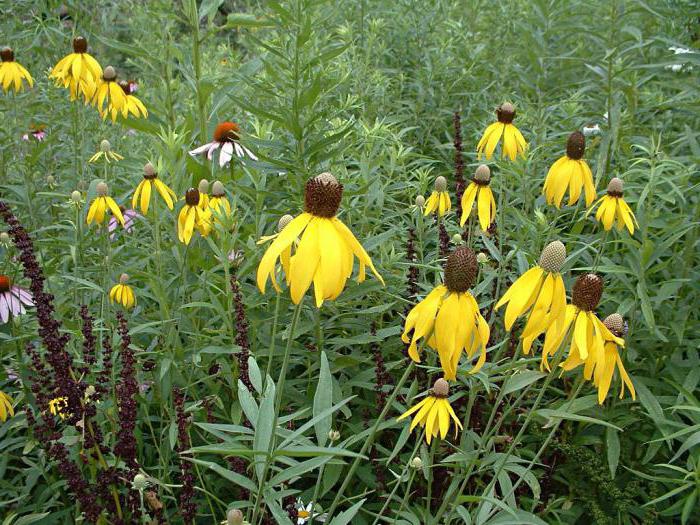

Correct care of ratibid columnar
If you want a lot of butterflies to settle in your flower bed, then the Mexican hat plant is what you need. The flowers of this culture emit a special aroma and components that are very fond of some of the most beautiful inhabitants of our planet.
Choosing a landing site. This is an important condition for growing columnar ratibide. In order for the bush to develop well and delight for a long time with its unusual flowers, it should be planted in areas with a lot of sun. You can take any soil for a flower. An excellent option would be a loamy substrate with neutral acidity.
It is not recommended to plant the plant near water bodies. Ratibida columnar poorly tolerates excess moisture.
Irrigation. The bush does not need frequent watering. This procedure should be carried out only if the soil is very dry and after weeding. For this, water must be used standing or rainwater.
Fertilizer. As for feeding, there is no special schedule for this crop. Thanks to its well-developed root system, the flower is perfectly capable of extracting useful components for itself. Several fertilization applications are sufficient per season. Complex preparations are best suited. You should not get carried away with such mixtures, since their excess can cause the rapid development of green mass and reduce the flowering period.
Seed collection should be carried out after the plants have faded and dried well. To do this, you need to cut off the boxes with a sharp knife and grind them into dust, thus freeing the grains from other parts.
In the fall, when the fruit is harvested, the stems will need to be cut. It is not necessary to cover the bushes for the winter, they perfectly tolerate low air temperatures.
Diseases and pests
As a rule, the Mexican hat almost does not suffer from diseases and is rarely attacked by insects. At times, the flower can be affected by all sorts of garden spots and, which is extremely rare, powdery mildew. In this case, it is necessary to remove all areas infected with the disease and spray the plant with a fungicide.
If, when preparing the site for planting the ratibide, little attention was paid to drainage, then the plant may suffer from decay of the root system.Unfortunately, this process is irreversible. In this case, the bush should be removed, work should be done to improve the drainage system, and only after that a new flower should be planted in this place.
Propagation of ratibide by seeds
To grow a new plant, you can use both the cuttings method and grains. The second method is one of the simplest and most effective. With proper care, the flower is able to reproduce itself, thanks to abundant self-seeding.
It is easy to grow columnar ratibide from seeds. Sowing seeds for seedlings should be carried out in early February. This rule must be observed, this will allow the bush to please you with its flowering in the same year.
Before placing the grains in the soil, you need to:
- Stratify the planting material (all grains should be kept at a temperature not exceeding 70 C for about 30 days).
- The earth should only be used with neutral acidity.
- To make the grains germinate faster, you need to cover the container on top with polyethylene.
- A pick should be carried out when two full-fledged leaves appear on young plants.
- Plant on the site in mid-May, and until that time keep in a cool room.
Before planting seedlings in a flower bed, you need to harden them a little. To do this, within two weeks, the container with young plants should be taken out into fresh air, constantly increasing the time. Before moving them to the flower bed, the soil in the flowerpot must be watered and wait about two hours. At the end of this time, the pots from each plant should be removed, preserving the integrity of the earthen coma and placed in a pre-made depression.
Sowing seeds can also be carried out directly into open ground. The procedure should be carried out in March or April. The seeding period depends on the region and weather conditions. Before placing the planting material in the soil, the site must be carefully dug up and well leveled. Then make paths with a depth of about 2 cm.The distance between the rows should not exceed 30 cm.If the seedlings are dense, then they will need to be thinned out, keeping the distance between the plants at 35 cm.
The seed propagation of the columnar or "Mexican hat" ratibide described above further confirms the simplicity of its cultivation. Observing simple rules, you can radically transform your site in a short time and fill it with incredible aromas.
Ratibida is a large flowering plant with expressive inflorescences, thanks to which the flower is called the Mexican hat or Sombrero.
The homeland is considered to be the vastness from Mexico to Canada, it also takes root in our latitudes. Loved by butterflies and goldfinches, ratibid will not only be a bright decoration for your garden, but will also fill it with a magical aroma.
Ratibida in landscape design
Before planning the inclusion of ratibide in the landscape design of the garden, it should be borne in mind that this flower is able to quickly spread by self-sowing and gradually displace other ornamental crops on the site. If this can be taken under control, then the flower will look great in mix compositions with rudbeckia, chamomile, aster. In addition, ratibida will work well with some undersized shrubs.
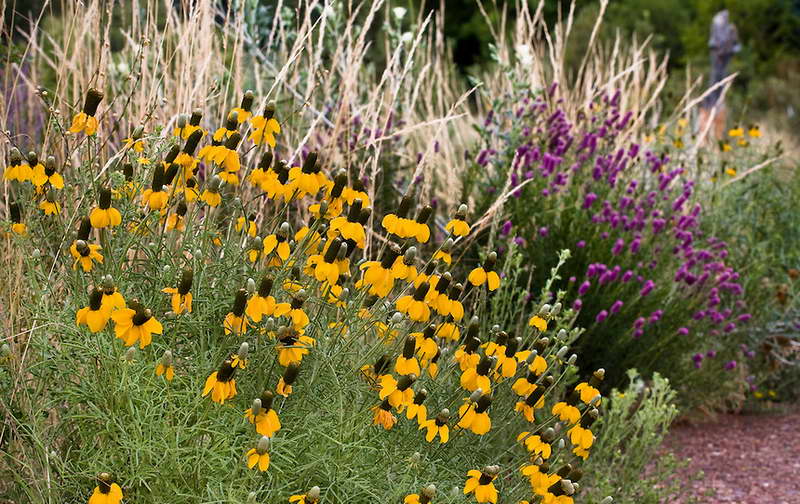

Ratibida in landscape design
Ratibida, Mexican hat, sombrero - it's all about her, the beautiful representative of the Astrovs. A free and strong flower can become a wonderful addition to any garden and delight with its unusual appearance throughout the summer season.
Growing ratibide from seeds
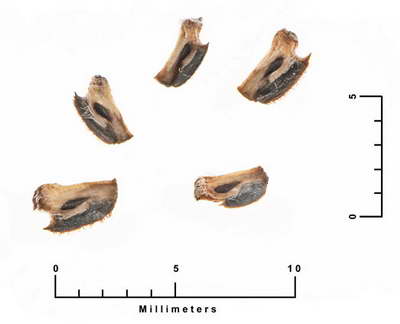

Ratibide seeds photo
Two methods are acceptable: cuttings or sowing seeds. Without renewal, the ratibid lives for 4-5 years, but is able to reproduce independently due to abundant self-seeding.
Sowing seeds for seedlings
To grow seedlings, you need to sow seeds in early February so that the plant has time to give color in the same year by the end of summer. The seeds can be bought or harvested by yourself.You need to wait until the boxes-cones are completely dry (they should turn dark brown), this will happen by the end of October, beginning of November.
- Before sowing, cold stratify the seeds - keep them at a temperature of 5-7 ° C for about a month.
- Sow in moist soil of neutral acidity, place the container with crops on a lighted windowsill, maintain the temperature at 20-25 ° C.
- You can cover with foil or glass to prevent moisture from evaporating.
- In a couple of weeks, the seeds will sprout together.
- When 2 true leaves appear, the plants can be dived and transplanted into separate containers. Then keep the seedlings in a cool place or greenhouse for 10-15 days, until the heat is established outside.
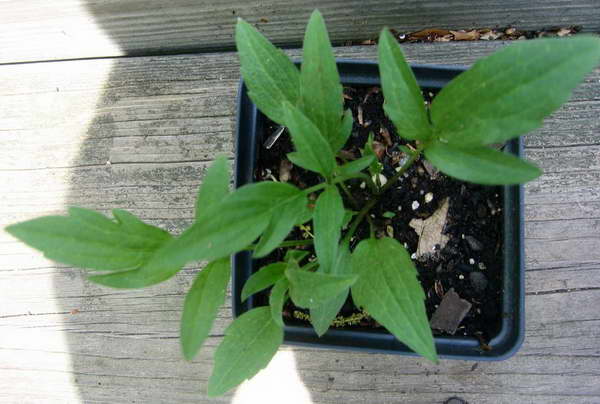

Seedlings of ratibida ready for planting photo
By mid-May, it can be planted in open ground, observing the distance between seedlings 20-25 cm.
Sowing seeds in the ground
For warmer regions, it is possible to sow ratibide seeds directly into the ground. In the south, it can be planted in February, a little further north - in March. The earth must be carefully dug up, leveled. Make small grooves up to 2 cm deep, maintain a row spacing of about 30 cm, sow seeds and sprinkle with earth. Dense seedlings will need to be thinned out, leaving 10-15 cm between the plants. Finally, they are seated at a distance of 30-35 cm.
Preparing for winter
Perennial chrysanthemums - planting and care in the open field
Preparation for the winter of the Mexican hat begins when the plant has completely bloomed and dried, and the core changes color from silvery green to dark brown. This means it's time to cut the fruit - small bolls - and collect the seeds. After the seeds are harvested, the stems should be removed by cutting them flush with the ground. Due to the fact that this plant is able to withstand even the most severe frosts, it does not need insulation measures.
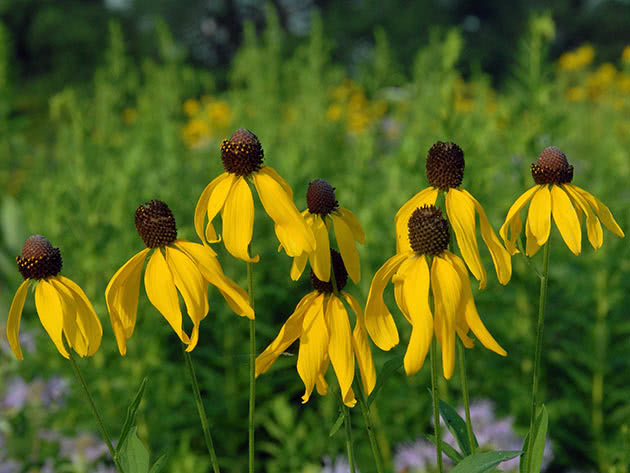

Ratibida pinnate
Types of ratibids with photos and names
There are two main types: columnar and feathery ratibid.
Ratibida columnifera
Ratibida columnar Mexican hat growing from seed photo
It is remarkable for its large flower up to 8 cm in diameter. The column-shaped core is surrounded by many hard petals that fall off during the flowering and maturation of the seeds. The petals are colored burgundy, yellow, orange, may have a yellow border. Most often, they begin to bloom from the second year of life. Stems are straight, stiff, grow in a small bush from one root.
Ratibida pinnata Ratibida pinnata
Ratibida pinnate Ratibida pinnata photo
Has a special structure of leaf blades. They are pinnate or belt-shaped, strongly elongated. The petals are yellow, pointed, ligulate. The pith is rounded, less elongated. Another feature: if you rub the foliage, you will hear a pleasant anise aroma.
Ratibida peduncularis
Ratibida peduncularis Ratibida peduncularis photo
A low-growing, stocky plant with beautiful wide leaves, cut with rare veins. At the bottom of the leaf and along the veins, the leaves are colored burgundy. Flowers on short stalks, with long cylindrical centers.
Description
A perennial plant has one or more straight stems up to 120 cm in height. Strong taproots are able to extract moisture from the depths of the soil, because the plant lives in sunny and arid areas. In the wild, it can be found in wastelands, roadside embankments, or on the prairies.
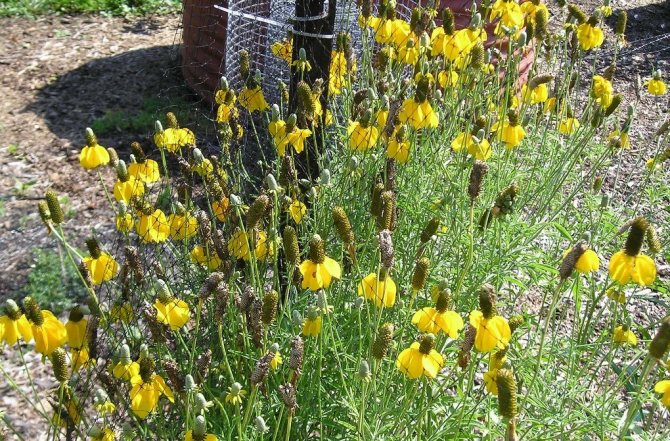

The foliage is gray-green, pubescent, divided into lobes. The length of the leaf plates ranges from 3 to 12 cm. Flowers on long stems open in mid-July and delight gardeners until late autumn. The flower has a pronounced protruding core in the form of a cylinder or cone, 2-3 cm long. In the lower part, the core is framed with soft hanging petals of a round shape, 1-3 cm long.In nature, you can find plants with yellow or burgundy petals, as well as mixed colors.
Ratibida description
Ratibida can be both biennial and perennial. The ground part is covered with small hairs. The stem is erect, branched, rough and leafy. Grows from thirty to one hundred and twenty centimeters in height. The plant has a rod and branched root system. Leaves of a grayish-green hue, grow from three to fifteen centimeters in length. The baskets resemble rudbeckia flowers: the cone-shaped middle consists of tubular flowers and from them radiating ligulate flowers hang down. Flowers can be yellow, red-brown, brown, red with yellow or brown with purple. The flowers do not open immediately, but in turn, starting from the bottom and going up to the top. The fruit is a winged achene up to four millimeters in length.
You can grow ratibida using a seedling and seedless method. Plant the seeds of the plant in open ground, both in autumn and in early spring in frost-bitten soil. In order to plant the seeds of a plant before winter, they do not need to be specially prepared, it is enough just to evenly distribute them in the prepared groove, sprinkle them with sand and insulate them with spruce branches.
Growing ratibids from seeds in spring requires mandatory stratification. To do this, you need to put the seeds in the bottom drawer of the refrigerator for thirty days. But it is best to give preference to the seedling growing method. The best time to plant seeds for seedlings is mid-February. Seedlings are very difficult to leave after transplanting, so it is better to plant seeds immediately in special pots made of peat.
The soil should be light and moist, it is best to use a mixture of peat with coarse sand and turf soil. It is not advisable to deepen the seeds into the soil; it is enough to press them a little. After planting, the pots are covered with plastic wrap to create a greenhouse effect, and germinated in a warm and bright place. If favorable conditions are created, the seeds will germinate in ten to fourteen days. After that, they need to be placed in a room with diffused light.
Flower structure
The ratibida flower rises above the foliage. This is a basket, the diameter of which is about 6 cm. Female ligulate flowers adjoin the lower part of the convex disc, their shape is obovate, and the length is 2.5-3 cm. The ligulate flowers are arranged in one row. They are bent towards the stem. The color in different species is yellow, yellow-purple, maroon. The columnar ratibid is characterized by a dark color - burgundy or brown with a bright yellow edging.
The flower disc is elongated, hemispherical. Initially, it is yellowish-green, its length can be up to 5 cm, and its width is more than 1 cm. About 400 small tubular bisexual flowers are located along the disk. During flowering, the disc becomes taller, becomes cylindrical and turns yellow-brown in color.
The fruits of the ratibida are small, light brown achenes.
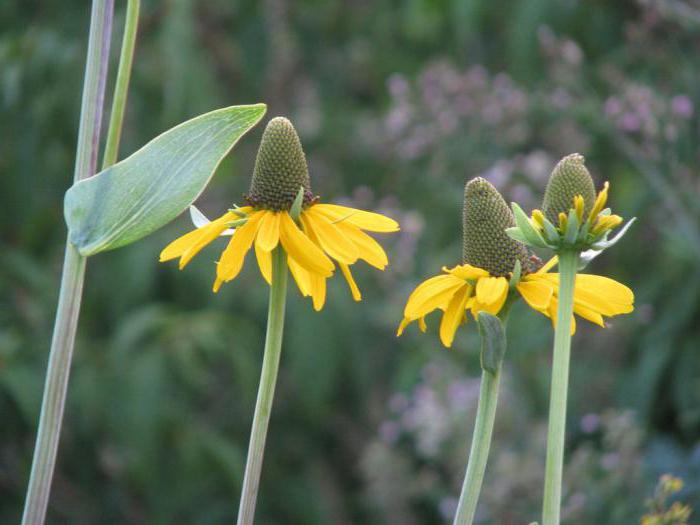

Planting and caring for ratibid outdoors
How to plant correctly
Seedlings are planted in open ground when the soil warms up enough, and night frosts will probably not return. Before planting the ratibide in the open field, it is necessary to harden the plants for fourteen days. To do this, it is necessary to take out the pots with seedlings to fresh air, starting at ten minutes and gradually increasing the time. The seedlings will be ready for transplanting when they can be outdoors around the clock. During hardening, it is very important that the seedlings do not stand in a draft and do not fall on precipitation.
For planting ratibids, a sunny area or partial shade is perfect. The soil should have a good drainage layer, preferably clay or loamy. The plant calmly refers to slightly alkaline, slightly acidic and slightly saline soil.Before planting the ratibide, wood ash and compost must be added to the soil during digging. Seedlings are planted in the evening or cloudy weather. The minimum distance between plants should be about twenty-five centimeters. If the seedlings were planted in peat pots, then they can be planted in open ground directly in them.
Flowering can appear under favorable hot conditions only by the end of summer. And if the weather is rainy, then flowering can only be expected next year. One year old ratibida can be grown in the garden for up to three years. To do this, it must be carefully dug up and planted, otherwise the stems will begin to lignify.
How to care for the garden
Caring for the ratibid is quite simple and does not take much time. If you want to control the process of plant reproduction, then you need to remove the family baskets in time. And if this is not done, then the ratibid will reproduce perfectly with the help of self-seeding. Watering the ratibide is necessary only in dry weather, if the summer is rainy, additional olive for the plant will not be needed. This should be done with warm, settled water. After each watering, it is necessary to carefully loosen the soil and remove weeds.
If during the digging before planting the ratibids, organic fertilizers were applied, then there is no need to additionally feed the plants during growth and flowering. An oversupply of fertilizer will result in lush green mass and poor flowering.
Ratibida rarely gets sick and is practically not attacked by harmful insects. Plants can rot due to rainy weather. The affected bushes must be removed, and the rest of the plants must be treated with a solution of fungicides. Powdery mildew can also sometimes appear, a solution with the addition of soda or special fungicides that can be purchased at any store for gardeners and gardeners perfectly helps to fight it. Heavily infested bushes are best removed from the flower garden.
Adult plant care
Ratibida prefers neutral or alkaline soils. Loams or clayey soil with the addition of lime are well suited for it. It is also important to provide the plant with good drainage and avoid stagnant water. In the garden, sunny places or a slight shade are chosen for her. The plant tolerates drought and frost very well, so watering is necessary only in very hot dry weather. For the winter, the roots do not require shelter, and the seeds can be sown even on frozen ground.
Ratibida is unpretentious and does not require special care, it does well without additional feeding. With an excess of fertilizers, it is possible to drive out greenery and reduce flowering. She receives all the necessary substances from the depths of the earth thanks to the developed rhizome.
The plant ages quickly, woody stems lose their attractiveness after 4-5 years. To rejuvenate the bushes, use new seedlings or more often divide and transplant.
Possible growing problems
When growing, problems with leaves may arise - they will lose their decorative effect. This is due to the fact that youngsters, to which the rose belongs, need to be updated in a timely manner, that is, every 1-2 years.
Pests
Ratibidu is insect and disease resistant, making it easy to grow.
Diseases
Prolonged rains can cause rot formation. In such a situation, damaged plants must be removed, and the soil is treated with a special solution of fungicides.
Important! Powdery mildew may appear at high humidity. It is found by a whitish bloom on plants. In this case, the bushes must be treated with a baking soda solution or a sulfur-containing fungicide. Severely affected plants are destroyed.
Choosing a place for planting and preparing the soil
When choosing a place to plant a ratibide flower, consider the following:
- For planting a plant, it is advisable to choose well-lit area... It feels good in partial shade.It is undesirable to plant a sombrero flower in very shaded areas with drafts and strong winds.
- A dry, well-drained planting site is preferable. It is not recommended to plant the plant in swampy areas, as well as in soil where groundwater is high, otherwise the flower may disappear.
- Grows well on loamwhich is neutral or alkaline. Can be planted in limestone and even rocky areas.
- Pick-up location need to dig, for 1 sq. m. soil add 10 ml of compost and 1 tbsp. wood ash.
Ratibida reproduction
This perennial can be propagated by cuttings or sowing seeds. It does not grow so long, only 4-5 years. Fortunately, the plant gives abundant self-seeding, which contributes to self-renewal. By dividing the bush, plants that are 2-3 years old can be propagated, but this process is difficult due to the core type of the root system. Shrubs should be divided in spring or fall. It is recommended to use a transplant trowel so as not to damage the root itself, and to preserve the soil with radical processes around it as much as possible.
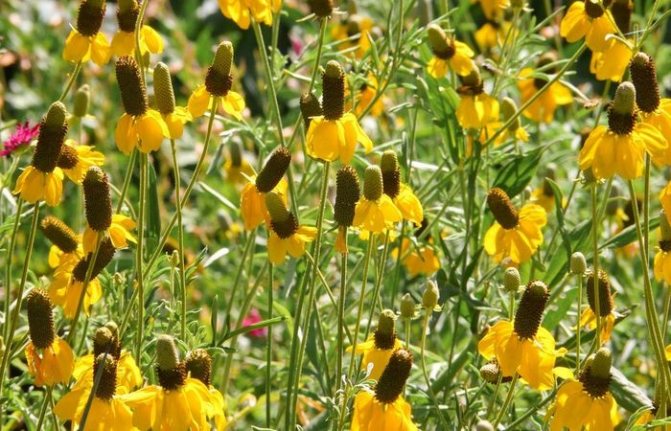

Transfer after purchase
When buying roses, you should carefully examine the condition of the stems and shoots. Experienced gardeners transplant plants from pots after flowering. Usually, plants do not easily endure this adaptation period. The first two weeks turn out to be the most difficult, and even loss of foliage can be observed.
Important! Having adapted, the rose grows quickly.
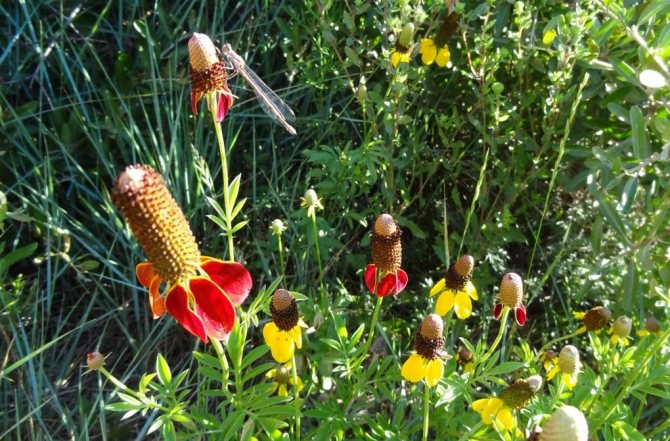

Ratibida columnar in nature
Reproduction
The division of the bush is used very rarely, since the root system is deep, it is difficult to do this. You can use 2-3 year old plants. The bush is carefully dug up, separated with a sharp knife or pruner. They try not to upholster the earth from the roots. The resulting plants are planted while maintaining the same planting level, watered abundantly and shaded for a while, until the flowers are accepted.
Before placing the grains in the soil, you need to:
- Stratify the planting material (all grains should be kept for about 30 days at a temperature not higher than 7 0 С).
- The earth should only be used with neutral acidity.
- To make the grains germinate faster, you need to cover the container on top with polyethylene.
- A pick should be carried out when two full-fledged leaves appear on young plants.
- Plant on the site in mid-May, and until that time keep in a cool room.
Before planting seedlings in a flower bed, you need to harden them a little. To do this, within two weeks, the container with young plants should be taken out into fresh air, constantly increasing the time. Before moving them to the flower bed, the soil in the flowerpot must be watered and wait about two hours. At the end of this time, the pots from each plant should be removed, preserving the integrity of the earthen coma and placed in a pre-made depression.
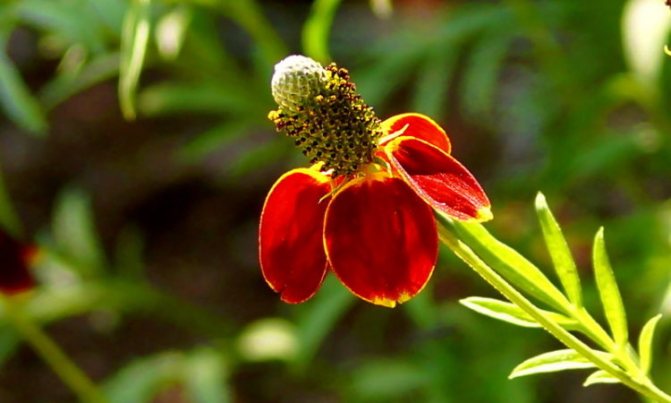

Sowing seeds can also be carried out directly into the open ground. The procedure should be carried out in March or April. The seeding period depends on the region and weather conditions. Before placing the planting material in the soil, the site must be carefully dug up and well leveled. Then make paths with a depth of about 2 cm.The distance between the rows should not exceed 30 cm.If the seedlings are dense, then they will need to be thinned out, keeping the distance between the plants at 35 cm.
Seed propagation of the columnar or "Mexican hat" ratibide, described above, once again confirms the simplicity of its cultivation. Observing simple rules, you can radically transform your site in a short time and fill it with incredible aromas.
This perennial can be propagated by cuttings or sowing seeds. It does not grow so long, only 4-5 years. Fortunately, the plant gives abundant self-seeding, which contributes to self-renewal.
When propagating by seeds, seedlings are sown at the beginning of February so that the ratibid has time to bloom by the end of the same summer.Seeds are harvested at the end of October or November, when the bolls of the cones are completely dry and turn a dark brown color.
Before sowing, the seeds are kept for a month at cold temperatures (5 .. 7 ° C), that is, cold stratification is carried out. Then they are sown in a moist substrate with neutral acidity and placed on a lighted windowsill at an air temperature of 20-25 ° C. To prevent moisture from evaporating, the pots or box are covered with foil.
After 2 weeks, friendly shoots appear, which dive and transplant into separate containers with the appearance of two true leaves. Fortified seedlings are transferred to a cool place or greenhouse for 10-15 days before the onset of stable heat. In mid-May, the ratibida is planted in open ground, keeping the distance between the plants 20-25 cm.
In warmer areas, you can sow ratibida directly on the open ground. They do it early, in the south - at the end of February, and to the north - in March. The earth is carefully dug up and leveled beforehand. At a distance of 30 cm, shallow grooves are made, 2 cm deep. As they germinate, the seedlings are thinned out in especially dense places.
You can propagate a plant 2-3 years old by dividing the bush, but this process is difficult due to the core type of the root system.
- Stratify the planting material (all grains should be kept at a temperature not exceeding 70 C for about 30 days).
- The earth should only be used with neutral acidity.
- To make the grains germinate faster, you need to cover the container on top with polyethylene.
- Carry out a pick when two full-fledged leaves appear on young plants.
- Plant on the site in mid-May, and until that time keep in a cool room.
Propagation of ratibide by cuttings is also a simple method, but it is rarely resorted to, because seed reproduction is very simple and varietal characteristics are preserved with it, unlike that of many other plants.
The grafting procedure should be started before flowering. To do this, cut the side stems next to the root and plant them in moist soil, pouring a couple of centimeters of sand on top of it. From above, the stalk is covered with a jar or a large bottle with a cut neck. After 15 days, rooting will end and the jar can be removed.
When growing ratibide as a perennial plant, it is necessary to divide the rhizome every couple of years. This procedure is extremely difficult, due to the long length of the root and the tenderness of the root system, and there is no guarantee that it will succeed and the plant will survive.
If you nevertheless decide to carry out this procedure, then do it in early spring and be very careful when dividing the rhizome, and also remember that the rooting of the cut is still quite rare.
Varieties and types
Transplanting ratibide
A transplant from pots to a flower bed is performed together with an earthen lump, placing specimens 30 cm apart.
In the first year after planting, until the bushes get stronger, flowering is unlikely to occur, and you can wait for it only by the end of summer, and if the season is cool, then only in the second year.
In open soil, sowing is carried out either in the spring, after the snow melts, or in the fall with the onset of stable frosts. The plot is prepared, as well as for planting seedlings.
When and how it blooms
The first year of the life of the bushes is not marked by exuberant flowering, only some roses bloom in a very hot summer closer to autumn.
Many flower growers cultivate such plants as annuals. If the ratibide is grown as a perennial plant, then there is a need to dig out the bushes every 2 years at the beginning of spring and divide the rhizome into parts. Since the roots are very long and delicate, the procedure is very difficult.
Important! You need to show maximum attention and patience so as not to damage the root.
Types of flowers
Ratibida columnar is used in landscape projects. It is recognized in massive plantings due to the special shape of a large yellow flower. Possesses meter shoots.
Another species called Red Midnight stands out in deep red flowers.
Cheyenne Yellow is popular with flower growers for its yellow petals.
Flower shapes
The ratibid has an interesting inflorescence shape:
- there is a brown cylinder in the center;
- it is made up of a huge number of small flowers;
- strongly curved petals are located around the cylinder.
Flowering period
Wild roses bloom in May, their flowering period is short. At the end of May - June, garden roses delight with flowers. These species bloom mostly once, with a few exceptions.
Changes in care during flowering
During the flowering period, roses require proper care. At this time, the shoots are pruned, giving a certain shape and activating the dormant buds.
Types of ratibids and their characteristics
There are seven known varieties of this plant, but gardeners grow only two of them:
- Columnar - the height of the stem is 1 m. The plumose-dissected pubescent foliage has a delicate blue-greenish tint, and the flower is red, burgundy or yellow. The drooping petals are bordered with purple, yellow or brown borders. Due to the elongated 3-5 cm protruding core, the look is very similar to the famous Mexican hat.
- Feathery - most often grown as an annual plant, 1.5 m in height. Leaves of a complex lanceolate-pinnate shape. Flower petals that resemble a basket are yellow or brown in color. A small core protrudes above the inflorescence.
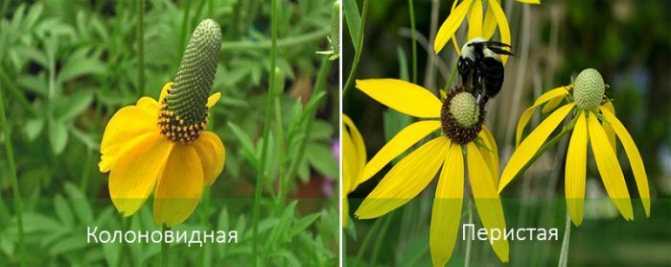

Gardeners prefer to cultivate ratibida, since the bush, with good care, blooms from May to the end of September and can grow in one place for about five years. Even in the absence of care, it will grow and delight with flowering, because it reproduces by self-sowing.
How to water and fertilize
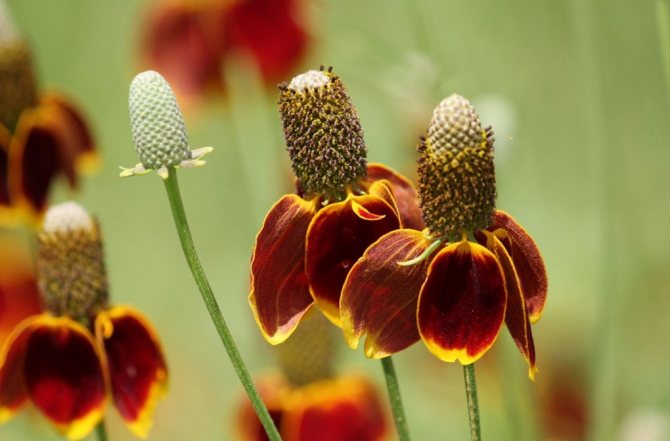

It is quite easy to grow ratibida in your garden, besides, it reproduces well by self-sowing. In order to exclude the possibility of uncontrolled reproduction of such a culture, it is necessary to promptly cut off the inflorescences that have begun to fade.
Such flowers need watering only during a prolonged drought, for this they use water that has settled well and warmed up in the sun. If it rains systematically in the summer, then additional watering of the ratibide is not needed. When the bushes are watered or it rains, the surface of the soil on the site must be loosened, at the same time all weeds should be removed.
Such a plant does not need feeding, all the more if it is grown in nutritious soil, the fact is that it has a tap root, which can extract nutrients from deep soil layers. If the soil contains a lot of nutrients, then this will cause the active growth of green mass, which will have an extremely negative effect on flowering.
Landing dates
It depends on which landing method you choose. If the flower is sown with seeds, then this can be done either in early spring, when the snow melted, in the south it is at the end of February, in other regions in March — early April or late autumn. It is necessary to plant seedlings in open ground when there is no threat of spring frosts.
Ratibida is planted in a seedless and seedling way.
Growing from seeds in the open field
If the seeds are sown in late autumn, then special preparation is not required. Grooves are made in the ground, planting material is evenly sown, sprinkled with sand and covered with coniferous branches.
If sowing is planned for the spring, then compulsory cold stratification is needed. Why the seed is kept for a month at a temperature of 0 to 5 degrees and only then sown.
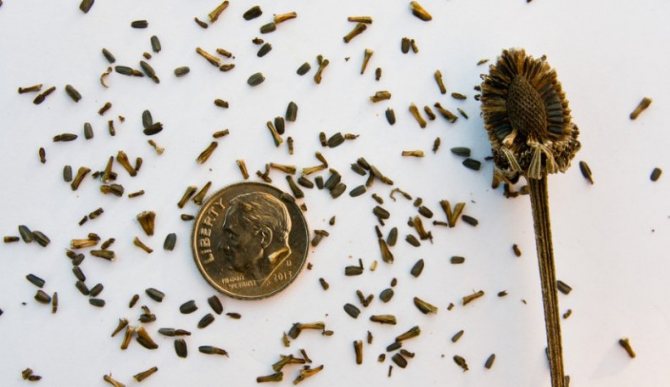

Seed material can be collected by yourself
Seedling method
Ratibid seeds for seedlings are sown in mid-February.Seedlings do not tolerate picking and replanting well, therefore, for sowing, it is preferable to use peat cups, which are filled with a moistened soil mixture consisting of peat, turf soil and coarse sand, taken in equal quantities.
Seeds should be planted shallow, and covered with cellophane or glass on top. After that, place the container in a warm, well-lit place. Somewhere after 2 weeks, the first shoots will appear, after which the film or glass is removed. The seedlings should receive a large amount of bright, diffused sunlight.
Half a month before planting seedlings in open ground, they must be hardened, for which they should be taken out daily to fresh air, for example, on a balcony or in a garden, but provided that the plant is protected from precipitation and drafts.
It is better to transplant seedlings into open ground in the evening. You can plant ratibida during the day when it is cloudy. The distance between the planting pits should be at least 25 cm. In order not to damage the root system, the seedlings are planted with an earthen clod, when the plant is planted in a peat pot, then together with it.
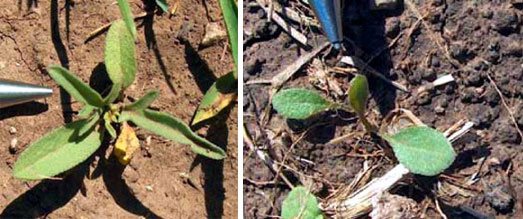

Saplings
In the first year, ratibid usually does not bloom, but sometimes it can please with its flowering in August, if the weather is very hot. If the flower is grown as a perennial, then in the spring the bush must be removed from the ground and divided into parts, which are planted in separate pits in a new area. If this is not done, then at the beginning of the growing season the shoots will become woody.
Prevention measures against pests and diseases
The plant is extremely resistant to various diseases and pests. The only threat can lie in improper care. So, excessive humidity leads to an attack of powdery mildew or aphids. Therefore, frequent watering is avoided, and the site is cleared of plant debris. The soil is fertilized with a mineral complex containing potassium and phosphorus and mulched with peat. Landscape designers prefer to plant ratibida next to rudbeckia and echinacea. This allows for a richer plant ensemble. Also, the flower is recommended to be placed in rockeries with ground cover plants.
Care features
Ratibida Mexican is unpretentious in care.
Watering
Does not like waterlogged soil. Watering the plant is necessary only if it is dry, hot weather for a long time or during the flowering period. Water should be used standing and warmed up in the sun. If the summer is rainy, then the flower does not need watering. When the soil is wet, it must be loosened near the plant and all weeds must be removed at the same time.
Top dressing
If the plant is planted in fertile soil, then it does not need to be fed. When the land is not very fertile, then a week after planting in a permanent place and before the formation of buds, mineral fertilizers can be applied. If there is a lot of nitrogen in the soil, then the plant will gain green mass, but it will not bloom.
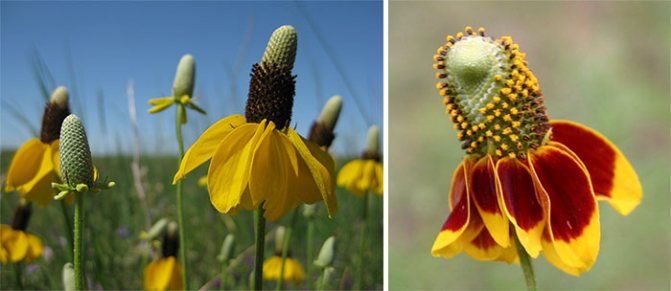

Care features
Ratibida blooms from July to October. So that the plant is strong and branched, and also pleases with abundant flowering, it is better to cultivate it on fertile soils.
It is possible to grow a flower in one place for up to 5 years, so it is advisable to renew the plant every 3-4 years. So that the Mexican hat does not lose its decorative effect, you need to regularly cut off wilted buds.
It is necessary to collect the seeds after the seed pods are fully ripe. This happens in mid-October and early November. After the flowers have dried, when the core turns brown, the box is cut off and rubbed in the hands to collect the seeds.
To prepare the plant for winter, you need to cut the bush in the fall either to the very ground, or leaving it up to 5 cm above the soil level.
Ratibida is frost-resistant, so there is no need to cover it.
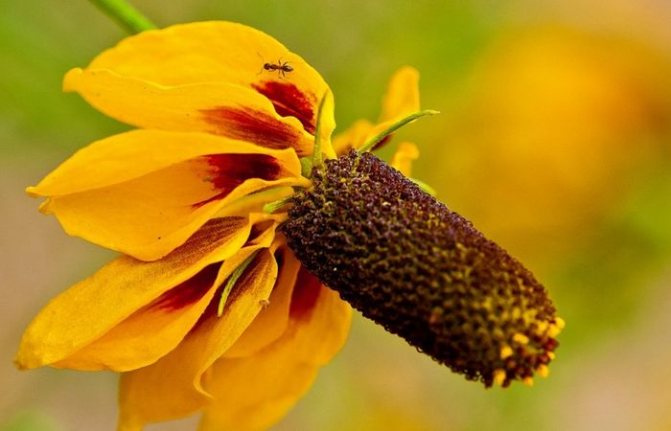

Ratibida: species, photos, planting and care, growing from seeds
Ratibida is a perennial plant with bright, sombrero-like inflorescences. The distribution area is a vast area from Mexico to Canada, but it feels good in Russian latitudes.The flower is unpretentious in care and soil quality, resistant to dry and hot climatic conditions. In our country, it is better known as the Mexican hat or prairie flower.
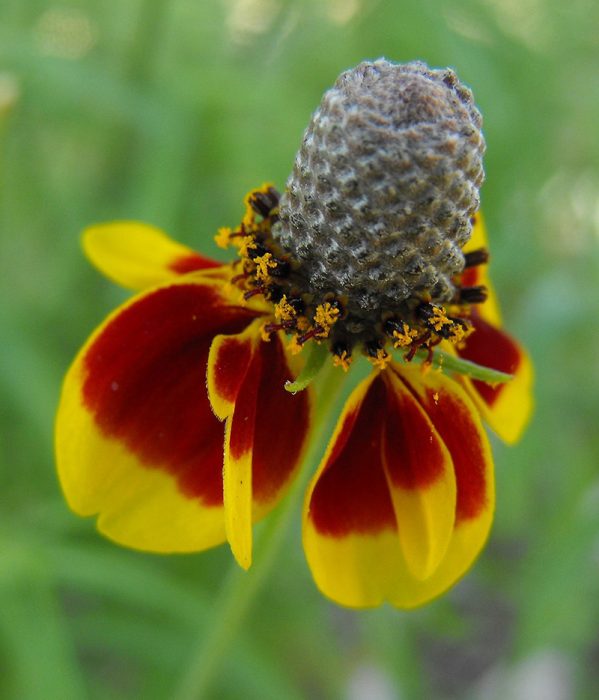

Where to Buy Ratibide Seeds
The Scientific and Production Association "Sady Rossii" has been introducing the latest achievements in the selection of vegetable, fruit, berry and ornamental crops into the wide practice of amateur gardening for 30 years. In the work of the association, the most modern technologies are used, a unique laboratory for microclonal reproduction of plants has been created. The main tasks of NPO Sady Rossii is to provide gardeners with high-quality planting material for popular varieties of various garden plants and novelties of world selection. Delivery of planting material (seeds, onions, seedlings) is carried out by Russian post. We are waiting for you for shopping: NGO "Gardens of Russia"
[/ td]
Mexican hat: what a flower looks like with a description and photo
The homeland of the plant is North America. In nature, the flower grows over large areas from Mexico to Canada. Ratibida is annual and perennial. Shoots are erect, with a rough surface. The stem is often one, but sometimes there are several. The height of the bushes can be from 30 cm to 1.2 m. Taproot. The leaves are greenish-gray or bright green, depending on the variety, the plate itself is deeply divided, its length is from 3 to 15 cm.
The flower has a conical center, which is formed by tubular flowers. It is 1 cm in diameter, and its height is 2-5 cm. Around the core are elongated petals up to 3 cm long. They are yellow, crimson-red with a yellow stripe along the edge, yellow-orange, burgundy. The fruit is a winged achene, about 40 mm long.
In nature, 7 types of ratibide are known, but only 2 are especially popular:
| Ratibida columnar (Ratibida columnifera) or columnar rudbeckia (Rudbeckia columnifera) | Ratibida feathery (Ratibida pinnata) or rudbeckia pinnate Rudbeckia pinnata) |
| The flowers are large, up to 8 cm, with a protruding, conical core. The color of the bush is gray-green, it itself is hard, slightly pubescent. The aerial part reaches a height of 1 m.Depending on the variety, the color of the petals may differ. In fine ratibida (var. Pulcherrima), they are two-colored: crimson-red closer to the center, and yellow along the edge. Cheyenne Yellow has yellow petals, while Red Midnigh has purple-burgundy petals. | The core of the flower is not cylindrical, but slightly flattened. It is surrounded by narrow yellow petals that have a mild aniseed scent. Plants reach a height of 1-1.2 m. |
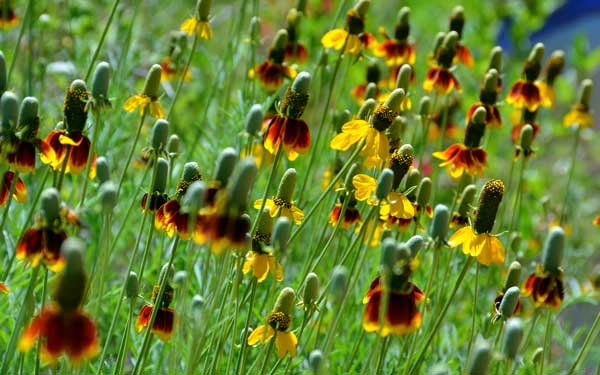

Ratibida columnifera
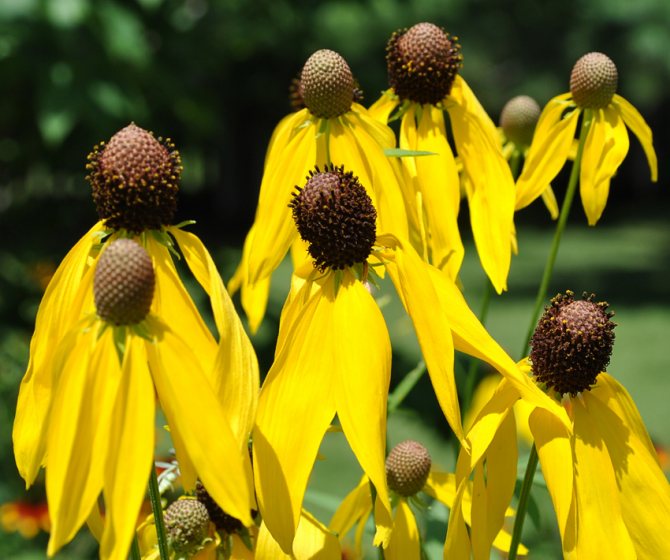

Ratibida pinnata
Both species are distinguished by drought and frost resistance.
The advantages of the prairie flower include the following:
- the plant multiplies easily, including self-sowing, while the flower retains its varietal characteristics;
- easy to care for, you just need to periodically loosen the ground near it and remove weeds;
- the flower is frost-resistant;
- the plant is resistant to diseases and pests;
- grows on almost any soil, including rocky;
- cut in water, the flower stands up to a week.
Of the minuses, it can be noted that the ratibid, multiplying by self-sowing, can grow throughout the site like a weed.
How to care for ratibid
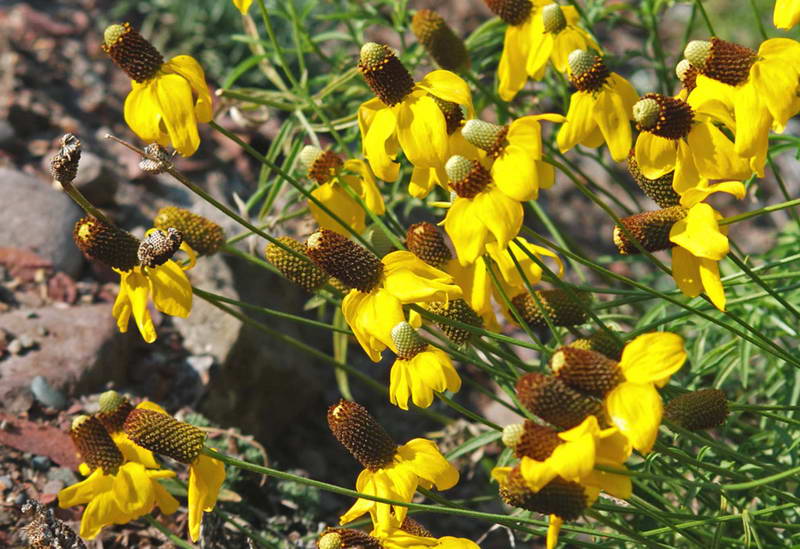

Ratibida sombrero growing from seeds photo
Alkaline or neutral soils are preferable, loams, clay soils with an admixture of lime are suitable. Provide good drainage, avoid stagnant water. Choose a sunny place, only a slight shade is possible. The plant tolerates both frost and drought well - water only in very dry hot weather. In winter, there is no need to cover the roots, and the seeds can be sown even in frozen ground.
Watering is minimal, and top dressing is not needed at all - the plant independently extracts the necessary substances from the depths of the earth. An excess of fertilizer will provoke the pasture of greenery, and flowering will decrease.
The plant grows old after 4-5 years, its stems become lignified, lose their attractiveness, the bushes need to be rejuvenated by division and transplantation.
Landing Ratibida
The plant is very unpretentious and adapts to different soils, alkaline, slightly acidic. It tolerates ratibide and weak soil salinity, grows on loam. But on nutritious, moderately moist and loose soil it feels most comfortable. Bushes develop well and bloom more abundantly. The ratibide needs good drainage so that there is no stagnation of moisture. Before planting, the soil must be dug up and cleaned. You can add wood ash, compost, sand to it.
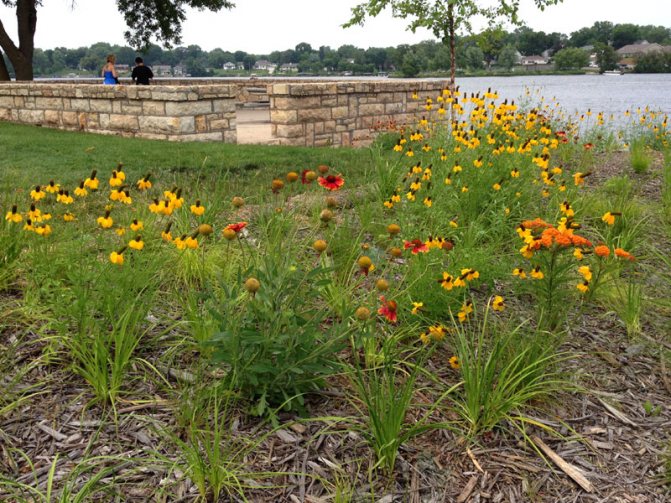

Cultivation and reproduction of prairie flower ratibids
Ratibida is very unpretentious in reproduction. The most common methods are: seed self-sowing, seeds directly into the ground, seedlings. Depending on climatic conditions, time and method of planting, the plant will bloom the next year or the same, but later.
Seeds
Cultivation of columnar and feathery ratibids from seeds in open ground begins with sowing in early spring, and in regions with a mild and warm climate even in February. Planting material can be purchased or obtained independently. The collection of ripe yellowish-brown grains is carried out from faded dried inflorescences with a dark brown cone. They ripen in late autumn.


The soil should be homogeneous, well loosened and free of lumps. To grow ratibide from seeds to be effective, it is sown in a neutral or slightly alkaline soil. However, it grows well on any land, as long as the latter is not too wet. It is not recommended to plant a plant near water bodies. It is necessary to sow in beds 2 cm deep at a distance of 30 cm. Watering is recommended only if the winter was not snowy.
Saplings
It is recommended to plant seedlings in cool regions. Sown in late autumn or early spring:
- The seeds are spread on drained wet (but not wet) compost, covered with a layer of substrate and placed in a lighted place.
- It is important to keep the temperature + 20… +25 ° С. In such conditions, the seedlings will sprout in a few weeks.
- Diving into pots is carried out after the appearance of the second leaf on the sprout.
- Then the seedlings are transferred to a greenhouse or greenhouse. For two weeks it is tempered by accustoming to the open climate and the sun. When it is strong enough to be transplanted into the soil, it is watered 2 hours before planting.
- Gently freeing from the pots, without disturbing the earthen lump, they are placed in pre-dug holes of the required size and sprinkled with earth. The root collar should be deepened by no more than 2 cm.


Dividing the bush
The method of dividing the bush is used quite infrequently and only for columnar ratibida, since it has a deep-set tap root system, and in the pinnate it is also very delicate. It is used to rejuvenate bushes. A bush 4-5 years old is carefully dug up and divided with a pruner or a knife, without knocking the soil off the roots. The seating level of the divided parts should be the same as before. In order for the plant to take root and take root faster, it should be watered regularly.
Cuttings
Cuttings are also rarely used, since the ratibide reproduces well by seeds. The procedure is carried out in May-June before the formation of buds. The stalk is cut at the root and inserted into a moist bud. Sprinkle it with sand on top and then cover it with a jar. After 14-20 days, the cuttings develop their own roots. Seedlings are placed at a distance of 30-35 cm from each other.
Signs of improper care
Such signs can be expressed in a change in appearance, for example, loss of color, yellowing of leaves. This happens with insufficient attention to chemical additives in the soil.
Aphids may appear as a result of improper watering.
The wrong landing site is the cause of many failures. You need to be especially careful in case of sharp long-term fluctuations in weather conditions.
Roses deserve the attention that flower growers give them. To grow such beauty in your garden, on your plot of land, is equivalent to a certain extent to improve your self-esteem, to bring joy to life.
Cuttings
Propagation by cuttings is also not very popular, it is much easier to propagate the plant by seeds. But if you want, then you need to carry out the procedure in May or early June before the start of flowering.
- Cut the stalk at the very root, stick it into moist soil
- Sprinkle with a layer of sand 2-3 cm, cover with a jar.
- In a couple of weeks, the roots will appear, remove the shelter.
- Further care is watering.
- The grown seedlings are planted at a distance of 30-35 cm from each other.


